SAINT CHARLES BORROMEO
Engaging audio for 3,400-seat sanctuary Singapore: MICA (P) 014/05/2023 PPS 1644/05/2013(022954)
THE PLATFORM WITH THE AMPLIFIER ON BOARD. AV LIGHTING SOUND REINFORCEMENT RECORDING STAGE SOUND BROADCAST July–August 2023 SIMPLYING CONSOLE PROGRAMMING

DESIGNING FOR INTELLIGIBILITY

WESLEY HALL VIDEO SWITCHING
ON BOARD. Unica is the next-generation cloud based amplifier platform designed to provide a safe and consistent user experience for any size application, whatever your installation requirements and efficiency goals might be. Unica cloud based amplifier platform. Unlock the power of consistency.
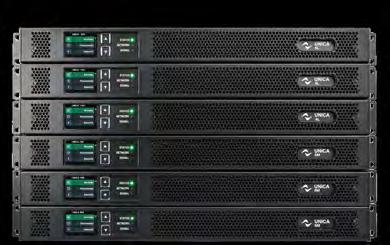
AMPLIFIER
THE PLATFORM WITH THE DANTE EMBEDDED MORE INFO
EVOLUTION WIRELESS DIGITAL
Setup simplicity. Digital clarity.
Experience the feeling of instant connection — with your music, your craft, your audience. Designed for musicians, audio professionals, and filmmakers, the Evolution Wireless Digital family includes three microphone systems that simplify setup, guarantee the most reliable UHF connection, and deliver superior sound quality. Evolution Wireless Digital is a powerful tool for those who put quality and performance above all else.
sennheiser.com/evolution-wireless-digital

Our world tour of features in this issue begins in Singapore where Richard has visited Wesley Hall at Wesley Methodist Church, which has recently undergone extensive upgrading work to offer an engaging contemporary worship experience for both in-person and virtual attendees.

From there, he travelled to the 111-year-old Saint Joseph’s Church which has overcome speech intelligibility as part of extensive restoration works.

Onto the US next where the vast, 3,400-seat Saint Charles Borromeo Catholic church can now deliver clear, enjoyable and engaging audio for its worshippers thanks to a new Danley speaker system. We also


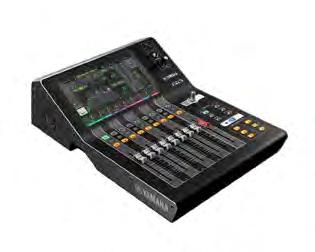
Church, Muldraugh Hill Baptist Church and Farmington Valley Jewish Congregation in the US as well as EWTN Global Catholic Network in Hungary.



Luke Gaschk from Advatek Lighting returns for the second of three lighting features this year, this time considering how pixel LEDs can be integrated into a DMX lighting system, while Casey Hawkins discusses the different types of video switchers and how each one might be suitable for your venue. And finally, John Black is on a mission to simplify lighting console programming.
I hope you enjoy the issue.
Follow us on social media @WorshipAVLMagazine




July–August 2023 WORSHIP AVL 3
All rights reserved. No part of this magazine may be reproduced or transmitted in any form or by any means, electronic or mechanical, including photocopying, recording or by any information storage and retrieval system, without prior permission in writing from the copyright owners.
LICENCES: Singapore: MICA (P) 014/05/2023 PPS 1644/05/2013(022954) CIRCULATION: circulation@worshipavl.com
Contact us Contents
2023 Issue 81 Email: kwallace@worshipavl.com PUBLISHED BY: 18 Upper Grosvenor Road, Tunbridge Wells, Kent TN1 2EP, United Kingdom Tel: +44 (0) 1892 676280 Web: www.worshipavl.com Libby Stonell Digital content editor lstonell@worshipavl.com Richard Lawn General manager rlawn@worshipavl.com Caroline Moss Contributing editor cmoss@worshipavl.com Nick Smith Digital media manager nsmith@worshipavl.com Adrian Baker Production manager abaker@worshipavl.com Carolyn Valliere Sales associate cvalliere@worshipavl.com Simon Luckhurst Senior reporter sluckhurst@worshipavl.com Sue Gould Advertising director sgould@worshipavl.com Chris Yardley Video editor cyardley@worshipavl.com Marne Mittelmann Circulation manager circulation@worshipavl.com COVER: Saint Charles Borromeo PRINTER: Times Printers Singapore COMMENT PROJECTS KNOWHOW TECHNOLOGY PRODUCT SPOTLIGHT TECH VIEW 10 World Outreach Church 12 Muldraugh Hill Baptist Church 14 Wesley Hall 18 EWTN Global Catholic Network 20 Saint Charles Borromeo 24 Farmington Valley Jewish Congregation 26 Saint Joseph’s Church 30 Designing for intelligibility 32 Dramatic displays without drama 34 Simplifying console programming 36 Powering up with Unica 38 Video switching 40 Integrating pixel LEDs 4 Azizi Ala, Robert Soo and Don Boomer 58 WPS 44 The industry’s most comprehensive product news 42 Robe plays FOOTSIE Editor’s Letter NEW PRODUCTS 4 12 26 32 40 44
July–August
Switching in mosques

AV setups
THE OBJECTIVE OF AN AV system is to provide users with the ability to see or hear video and sound sources on viewing stations and sound systems or speakers. For this reason, sources need to be captured, played, switched and displayed through the user interface using push buttons on hardware equipment or digital interfaces on computer-based technologies such as touch panel devices. In this article, I will further explain the design of visual systems in mosques and, in particular, the topic of switches and displays.
AV switches and Ethernet switches
There are similarities between traditional AV and AV-over-IP systems that are the main components in an AV environment. Both setups’ components are similar whereby in AV-over-IP, the AV switcher becomes the Ethernet switcher as a core part of the system for switching purposes. The AV switcher is hardwired, circuitbased switching and uses point-topoint technology – various sources with different output formats for a camera, recorder, player and even an AV transmitter will be feeds and can be managed. A multiformat AV switcher will be able to accommodate all these source devices. A matrix AV switcher is also advantageous for mosques as they typically have large and separated areas or rooms on different levels.
The matrix AV switcher comes with
a feature that allows users to assign input sources to designated output displays when divisible mode or multimode are activated, for example an event in a specific area of the mosque.
ports, which are limited and the system architecture not expandable. In this case, whenever physical ports – either input or output – are exhausted, multiple Ethernet switches can be connected to expand and scale up the number of ports as much as is needed. An AV-over-IP system architecture requires an encoder for input sources and a decoder for output displays, and several system designs require a network controller connected to Ethernet switches as well. All configurations of the equipment including input preferences, signal routing and advanced processing
the terrace and the corridor which is an outdoor area that has its own specific lighting level and is generally between 300–500 lux. Projectors and screens are often installed in indoor areas due to lowlevel lighting, with screen sizes and projector brightness being subject to several factors such as viewing distance of the congregation, lux level and screen gain. However, the main challenges for this solution are about aesthetic value in that users are sensitive to seeing any visible mounting bracket for the screen and projector. For this reason, a short-throw projector, pantograph lift and customised screen enclosure box installation are being commonly used to overcome this challenge. Alternatively, there are options to consider using a multi-display videowall or LED videowall to replace the screen and projector solutions if there is enough money in the budget. Typically, the narrower the gap bezel of the display, the higher the cost. The same goes for LED panels for narrow pixel pitch.
More advanced AV switchers can perform processing operations such as scaling for matching input/output resolution purposes and multi-window functions including picture-in-picture for overlaid live camera feeds transferred into sermon slides/presentations during Friday prayers. Taking all these things into consideration, the traditional AV solution using an AV switcher is still a reliable and preferred solution by certain users based on the system design requirements.
What’s different about Ethernet switches is the use of packet-based switching whereby the number of ports attached to the switches is no longer limited compared with AV switcher

are mostly made through softwaredefined (either web-based) interfaces or product apps provided by the manufacturer.
Besides the scalability of the system, the consideration to use Ethernet switches in mosques is because the extended distance between equipment can be attained through stacking the units. They’re suitable for installation on large-scale mosques as the cost of the installation can potentially be reduced.
Displays
Generally, the displays are most commonly installed in the main prayer area, female prayer area,
In contrast in the outdoor areas, TVs are generally used and installed along corridors with a size of at least 65 inches for a maximum viewing distance of roughly 4m. TVs are the most suitable display to be used due to high contrast specifications which can cope with high-level lighting areas. Nevertheless, an external custom enclosure box for weatherproofing the TVs is needed as the unit will most likely be built for indoor applications only.
I hope that this article has provided a general overview of switches and displays and a better understanding of a mosque’s visual system. Next time, I’ll look at the challenges of implementing these systems in mosques. Until we meet again in the next article, take care and goodbye.

4 WORSHIP AVL July–August 2023
COMMENT
Azizi Ala considers the different types of switches and display solutions that can be used in mosque
Azizi Ala
Founder and technical director at Acousticon Sdn Bhd
A multi-display videowall
A pantograph lift and screen enclosure box
Introducing the world’s most portable all-in-one television studio!
The new ATEM Television Studio HD is a professional live production switcher built into a broadcast control panel so it can be used for high end work while being extremely portable. You get a powerful switcher with 8 standards converted SDI inputs, 2 aux outputs, 4 chroma keyers, 2 downstream keyers, SuperSource, 2 media players and lots of transitions! There’s even an ISO model that records all 8 inputs for editing!

Easy to Use and Fast to Learn!
There’s never been a switcher that’s easier to use, as you simply press any of the program row buttons on the front panel to cut between video sources. You can select from exciting transitions such as dissolve, or more dramatic effects such as dip to color, DVE squeeze and DVE push. You can even add a DVE for picture in picture effects with customized graphics. Then you can live stream the results!
Self Contained Broadcast Quality Switcher
ATEM Television Studio HD combines a switcher and control panel into the same unit, so it’s extremely portable. The front panel includes buttons for selecting sources, triggering transitions and setting up video effects. You also get a built in t-bar for manual transition control! The front panel even has an innovative audio mixer control area with live metering on a dedicated LCD.
www.blackmagicdesign.com/sg
Record to Internal Network Storage!
ATEM Television Studio HD8 ISO supports recording all video inputs to optional M.2 internal flash storage! The internal storage will then be available to share over the local Ethernet network so you get a whole post production workflow! This means people can work on post production tasks such as editing, color correction and graphics preparation while recording new live shows!
Built In Fairlight Audio Mixer
With a built in Fairlight audio mixer, ATEM Television Studio HD makes it possible to do complex live sound mixing. The internal mixer features enough channels for all SDI inputs, as well as extra channels for the XLR, RCA and MADI inputs! Each input channel features the highest quality 6 band parametric EQ, compressor, limiter, expander and noise gate as well as level and pan controls.
ATEM Television Studio HD
From S$4,045
Learn More!
SRP is Exclusive of Taxes.
Let’s do it better! Developing the art behind sound mixing
WELCOME TO THE FOURTH EDITION
of “Let’s do it Better!”, a series that aims to elevate church AV to new levels of excellence. I’ve often been asked to touch on the subject of sound (music) mixing because churches and commercial venues alike have come to realise that no matter how good a sound system is, it ultimately hinges on how well the operator manages the sound mix.
Many would expect me to dive straight into the tech realm of signal processing like EQ, compression, gates, reverbs, delays and so on, because it is believed that these are the key factors to achieving a professional-sounding mix. But, instead, I will always begin by focusing on the subject matter and touching on non-technical topics like having a deeper understanding of different music genres and the various musical instruments used in such music, how they are played, how they sound (and tuned), their specific roles in a band and, depending on the specific genre, how each contributes to a unique part in the tapestry of music. I will then discuss vocal elements in church music, the worship leader, worship singers and choir, their specific roles that defines their tone, position, layer
It is also important to understand the music culture of the church, whether it’s traditional or leaning towards high-energy contemporary, as this will help sound operators make the right decisions when mixing for their respective worship services. Such is the often missing and neglected art that ought to be the foundation behind every sound mix, for without it will only result in a lacklustre, unmusical and unmoving wall of sound. Once grounded in these fundamentals, the next focus would be on pre-mix disciplines that focus on proper setup of input sources (instrument level, tone, M/S outputs and effects, for example), applying the right mic’ing techniques on instruments and vocals and setting proper gain structure, as these are absolute essentials to ensuring a good-sounding signal downstream. And only after all that is done, I will (finally) proceed to talk about signal processing, sound staging, imaging and the whole nine yards.
Let me share an unforgettable encounter at a church some years ago, and perhaps you can better appreciate why it is so important for sound operators to be grounded in music fundamentals before taking the reins behind the mixer. I attended


the worship segment of the second service, and yet again the bass guitar wasn’t in the mix. I couldn’t help but walk over to the sound operator and
be a challenge to get the right-sounding results. Let’s follow up on this analogy with something more familiar. I suppose we all know what an eagle looks like, but yet when we’re tasked to draw one, each of us will produce a very different rendition of this majestic bird. Some may turn out nicely with at least some resemblance to an eagle, but for others, like myself, it would probably look more like a chicken pretending to be an eagle. I can definitely picture what an eagle looks like, but my problem is that I have never been taught how to draw eagles, so I wasn’t able to use my drawing tools to translate that mental image onto a canvas. Likewise, novice sound operators need training, guidance and lots of practice before they can actually produce a good-sounding mix. Another question we should ask ourselves: what constitutes a good balance of tone and levels between the different musical instruments?
Let’s assume a simple four-piece band consisting of drums, bass guitar, electric guitar and keyboard, but even with only four instruments, sound mixing can still be a daunting task for an untrained sound operator. It gets even more
6 WORSHIP AVL July–August 2023
COMMENT
Robert Soo discusses the importance of understanding the music culture in churches and how this will help sound engineers mix worship services
Knowing what we are mixing is fundamental
complicated when you consider that the acoustic drums already require you to mix eight or more channels. What then is the right tone and balance between the snare, kick, toms, hi-hat and cymbals?








Whenever we come across a great sounding drum mix, be it live or on recording, we may not realise what it actually takes to get there. Firstly, a properly tuned and balanced set of drums, because a great sound always starts from the source. Particularly in live mixing, you cannot simply correct off-pitch toms, a flabby kick or a dull tarnished cymbal with signal processing. Secondly, the right selection and placement of microphones. Users often focus only on investing in good microphones but neglect learning the right mic’ing technique. Besides not capturing the instrument properly, a poorly positioned microphone will also lead to undesired noise bleed into
the mic channel, all of which cannot be corrected with processing, and microphone bleed is detrimental to any sound mix. Finally, and the most important of all, the people behind it –masterly strokes executed by a skilful drummer and an experienced sound engineer who tapped into years of music experience and made expert use of signal processors to produce that sweetsounding drums.












It wouldn’t be possible to touch on all aspects of sound mixing in this short article (especially on signal processing, a topic for the next article perhaps), but it should at least help us recognise that in our journey to excel at it, it is just as critical to develop the art behind sound mixing and not just focus on learning the mixer technicalities alone. There is more that I would like to share, so do look out for my next article. Till then, take care and God Bless.







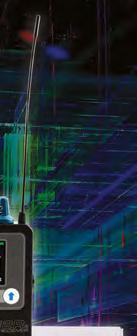



July–August 2023 WORSHIP AVL 7 Dante™ digital and analog line-level inputs Phenomenal Stereo Imaging 2 stereo transmissions in 1/2 rack unit 470 - 608 MHz tuning range NEW, improved M2Ra US Made Lectrosonics quality You haven’t heard an IEM with True Stereo imaging until you’ve heard Duet.
STE
EO
E
Fo r Y ou r Nex t St a g e TRUE STEREO IEM For Your Next Stage USA 1-800-821-1121 In Canada, call 877-753-2876 InEurope, call +33 (0) 78558 3735 In South America, call +57 310799 4564
T R UE
R
I
M
COMMENT
Important pre-mix fundamentals for a good-sounding signal downstream
What does it take to get a great-sounding drum mix?
Supercharge your wireless IEM system
mics as closely together as possible (at least 600kHz apart) and your ears as well. The bandwidth of that cluster essentially adds itself to directly above and directly below the cluster bandwidth. The idea here is to keep the clusters far enough apart as not to overlap. Definitely keep this in mind when planning new wireless purchases (see Figure 2).
Since antennas always interfere with each other’s performance, use antenna distros for your wireless mics and antenna combiners for IEMs. The goal is to have one A/B pair for the mics and one transmit antenna for the ears. The preferred
IN-EAR MONITORING (IEM) systems are gaining popularity day by day. They certainly make the sound mixer’s job easier as there is no feedback, and leakage from wedges is eliminated. This is especially a benefit if you are streaming your productions. Unfortunately, analogue wireless systems lose sonic quality as the RF signal degrades, even a little. So here are some tips to help get the best sonic performance and greatly improve reliability.
First, beltpack receivers need to be on your belt and out of your pockets. When a beltpack is in your pocket, the antenna is only the thickness of a piece of cloth away from your skin. The difference between that and ½-inch away from your skin could lead to a 40% reduction in signal strength. This gets even worse when that antenna gets up close to sweaty skin during animated performances.
Antennas from both wireless mics and wireless IEMs need to be separated by at least 1.8m each. Do not mount wireless mics and IEMs in the same rack without remoting their antennas. Of course, antenna farms like this should be shunned, but you already knew that (see Figure 1).

Receiving antennas and transmitting antennas cannot be pointed at each other. This is a
similar problem to pointing your mic at a speaker and getting feedback. Antennas should all be mounted on the wall facing the same direction or placed at 90º angles to each other. You will have no way to avoid this when using whips as they are omnidirectional in the horizontal plane.
The next step is careful channel assignment. To prevent generating any extra intermod, which will lead to dropouts and loss of open channels to assign to, cluster your mics at one end of the band and your ears at the other. Pack your

antenna for IEM transmitters is a “circular polarised” model. Unlike wireless mics, IEMs are almost
always non-diversity so you don’t have a second antenna when bending or twisting your body causes the reception of your beltpack to lose signal strength. If you are using a whip or a paddle antenna in a vertical position and your beltpack is hanging vertically off your belt, you will get maximum performance. But if you were to lay flat on your back (horizontal), your beltpack receiver would only be picking up less than 1% of what it did when you were standing upright. The sonic quality of your beltpack will track these differences as you bend and twist onstage, resulting in hiss, distortion and birdies in your ears (even if you don’t drop out). In addition, the actual frequency response in your earbuds will shift and you could likely lose an entire octave of HF response.
Lastly, for best performance, reduce the power of your IEM transmitters to the lowest power that will give you the range you need to cover. Reducing your Tx power from 100mW to only 10mW does reduce the strength of your signal by 10dB but it also reduces intermodulation generation by 30dB (that is 1,000 times lower). Typically, 10mW of transmit power should easily cover a 30m stage. It should also be mentioned that circular polarised antennas add a fair amount of passive gain (which is not subject to IMD generation; see Figure 3). www.rfvenue.com

8 WORSHIP AVL July–August 2023
COMMENT
RF Venue’s senior applications engineer, Don Boomer, shares tips on how to get the best sonic performance from your IEMs
Figure 1
Figure 2
Figure 3
WE STRIVE FOR SIX OUT OF FIVE

Neumann’s acclaimed studio monitor taken to a new level

◻ DSP engine for improved performance and automatic room alignment
◻ Linear frequency and phase response
◻ Novel 5.25“ woofer + 1“ driver, 145/100 W

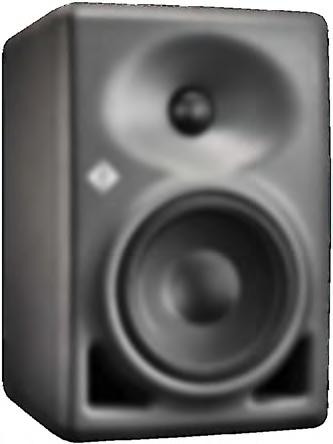
◻ Analog and S/PDIF inputs, optionally AES67

STUDIO MONITOR SYSTEMS MA 1 App (Mac/PC) www.neumann.com KH 80 KH 150 KH 310 KH 420 KH 750 KH 810 KH 870 KH 120 II
KH 120 II
KH 120
The power of projection
projection mapping and real-time compositing offer them, companies such as DWP Live from Nashville are able to seamlessly support them and their creative partners both during the planning and actual project execution stage.
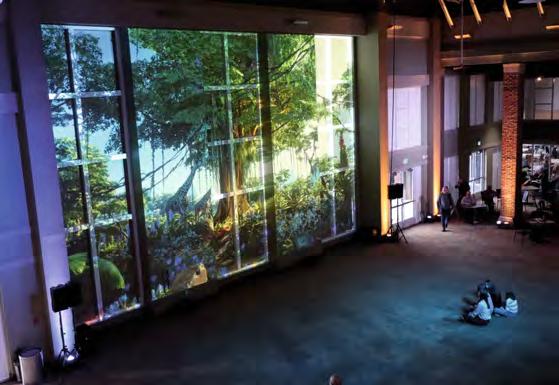

DWP Live recently helped the World Outreach Church with its “Sanctuary of Scripture: The Walk Way” capital campaign – an emotionally engaging initiative to raise funds for the expansion and improvement of the church’s current campus facilities. One part of the multi-faceted campaign included an installation consisting of mapped indoor projections to display stunning, interactive imagery for visitors as they walk through the campus’s pedestrian-only spaces.
Fivestone Studios’ Traylor Woodall enlisted DWP Live to help transform its concept design, storyboards and custom-created content into an
inspiring projection mapping visitor experience which would become an integral part of the onsite presentation of the fundraising campaign. A PIXERA media server licence installed on custom-built DWP Live hardware and two Barco UDX 4K32 projectors were the key equipment components of the installation.
One of the practical challenges during the setup process involved covering a number of designated
glass surfaces, while leaving the connected mullions and architectural elements exposed. “We decided to custom paint foam core to match the walls, so that there was no colour shift across the projection façade,” explains DWP Live CEO, Danny Whetstone. In order to focus on the simplicity and user friendliness of the final installation, the DWP Live team created a content loop and connected the lighting elements via
of employing AV Stumpfl’s PIXERA platform for the installation: “I really love the intuitive simplicity of the main PIXERA GUI, which allowed us to easily and efficiently deliver native 4K content to the projection system. The ability to sync the grandMA lighting console via timecode was another plus, because it meant that the lighting looks could chase the timeline perfectly without requiring additional operators for such a long run of the show.”
The World Outreach Church’s executives and their tech team were so impressed with the final setup’s “impact, reliability and ease of use” that they decided to extend the original run of the installation by an additional three weeks. www.dwplive.com www.fivestonestudios.com
10 WORSHIP AVL July–August 2023
www.pixera.one
PROJECTS
Images courtesy of DWP Live
ON YOUR MARKDATA - GO!

Modular system for customized infrastructure solutions
Wide range of modules for fully networked media technology concepts



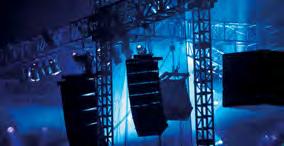


Classified cable-bulkware according to EU Construction Products regulation (EU CPR)
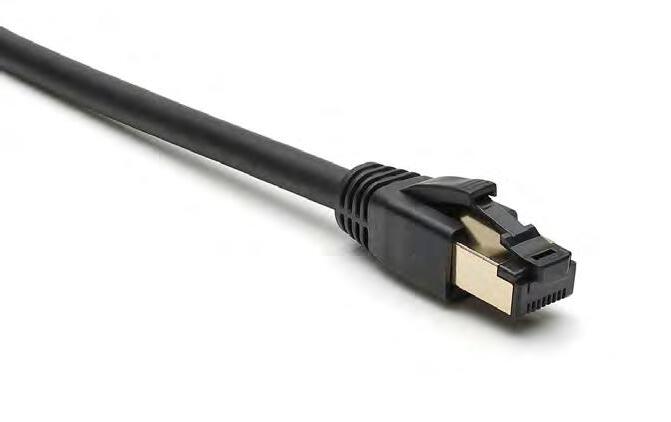




Ready made Network and Fiber Optic Systems for mobile and installation applications



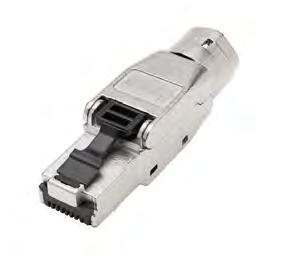


CPR-rated CAT.7 & CAT.8 installation and connection cables
June 14th to 16th 2023
SOMMER CABLE based in Straubenhardt/Germany was founded in 1999 and is now one of the leading suppliers of professional high-quality cable and connection technology with a focus on the audio, video, broadcast, studio and media technology sectors. The product range including the in-house brands HICON, CARDINAL DVM and SYSBOXX covers cable bulkware, connectors, connection cables, individually adaptable distribution systems and electronics.
A B2B shop with over 25,000 products is available 24/7.
Professional Studio Event Technology
x01735
Booth 2322 Orlando, FL, USA
BULK CABLE · CONNECTORS CATALOG FOR FREE · ORDER NOW! NEW 2023 www.sommercable.com • info@sommercable.com
High-quality, certified connection components
Musical transformation PROJECTS
LEA Professional Connect Series amplifiers have revived the music and ministry at Kentucky’s Muldraugh Hill Baptist Church


MULDRAUGH HILL BAPTIST
Church in Lebanon, Kentucky, is no stranger to exceptional music. Lebanon was an entertainment
hotspot in the ’50s, ’60s and ’70s, hosting classic musicians such as Chuck Berry, BB King, Creedence Clearwater Revival and
Jerry Lee Lewis at local clubs. So, it’s no wonder that great acoustics are important to the culture and history of this small town. The nearly 150-year-old Muldraugh Hill is among many Baptist and other denominational churches in the area that are transforming the dynamic of their services through audio, video and lighting. Now, music and ministry have been brought clearly and vividly to life thanks to a recent audio upgrade from JCA Media and LEA Professional amplifiers.
JCA Media played a pivotal role in the church’s transformation. The company is a media partner in the Commonwealth of Kentucky and many surrounding states, and has gained a glowing reputation in the house of worship market due to its fine-tuning and tailoring installations to the needs of each church.
“We get tired of churches being sold things they don’t need,” says Alex Peake, project manager for JCA Media, and AV technician at his local church. “We give churches what they need – quality equipment and a well-done installation. I have seen many installs where churches are sold things that are way above what was really needed for the job. Not that I don’t love quality gear, but you can go overboard with it if you’re not doing the right thing.” At Muldraugh Hill, the church was hampered by an ageing audiovisual system in its main sanctuary. The projector was propped up by hymnals, affectionately called “shymnals”, literally projecting on the wall from a laptop down in the front pew. The church had a centre loudspeaker cluster that didn’t cover the space adequately, and a choir monitor was hung 7.5m from the choir, so reverberation from the walls was a challenge.
12 WORSHIP AVL July–August 2023
The Allen & Heath SQ-5 at FOH
In other words, it was a challenge that JCA was well-qualified to handle. “We try to go into every install with the end goal in mind,” adds Peake. “We don’t want to lock you into a system that doesn’t allow room for growth but, at the same time, we want to give you a long-lasting system that will do the job well, fit your needs and grow with you.”
The audio portion of the installation uses a Danley SM100B loudspeaker, two SH Minis, two Cubes and four Nanos, all powered by LEA Professional 704 and 354 Network Connect Series smart amplifiers. An Allen & Heath SQ-5 digital mixer runs all audio, connected to Earthworks choir, pulpit and piano mics fed into ACE Backstage stage pockets and six Audio-Technica wireless mics.
“We were able to take a fourchannel LEA 704 and Smart Power Bridge the first channel for the main Danley SM100B loudspeaker. Then we connected a channel per front-fill, with a Danley cube on each side,” continues Peake. JCA’s team then used the fourth channel for the choir monitors and the four-channel LEA 354 powered the four stage monitors. “Both LEA amplifiers
are connected to the network via a Luxul switch so that we can use the LEA cloud monitoring feature,” he says. “I love the Smart Power Bridge function. I can create
LEA’s 704 and 354 Network Connect Series smart amplifiers, featuring 700W and 350W per channel respectively, are wellsuited for small- to medium-scale

the venue’s Wi-Fi or connect to any local area network via Cat5 or Cat6 cable. “Being able to troubleshoot for a client remotely, sometimes three-and-a-half hours away, is a service we love to provide to our clients,” adds Peake.
an L-C-R configuration with a subwoofer on a single four-channel amp because I can Smart Power Bridge the sub on a single channel and then do the left, centre and right. That really helps in a lot of our layouts,” comments Peake.
installations like Muldraugh Hill. The two-, four- and eight-channel amps feature HiZ (70V or 100V) or LoZ, selectable by channel. With three ways to connect, the church can engage the built-in Wi-Fi access point, connect to
The hills in Lebanon are alive these days with the sound of music from Muldraugh Hill Baptist Church. The pastor and congregants are thrilled with the new system, which helps bring renewed energy and life to weekly services and church activities. This installation is a perfect example of how even a small system with the right gear can be incredibly powerful yet simple. One person can easily run audio, lighting, projection and video from FOH. “We are firm believers in doing it the right way with the right gear the first time, and we won’t install low-cost, low-quality products. Our names are on it, we take pride in our work, we love what we do and we want it to be a lasting investment for churches as well,” says Peake. www.jcamediaky.com

PROJECTS July–August 2023 WORSHIP AVL 13
www.leaprofessional.com www.muldraughhill.org
The LEA amplifiers are connected to the network via a Luxul switch
True to Wesley
Electronics & Engineering Pte Ltd has installed a comprehensive AVL upgrade at Wesley Hall to make services more engaging

WESLEY HALL AT WESLEY
Methodist Church in Singapore has recently undergone extensive upgrading work to offer an engaging contemporary worship experience for both inperson and virtual attendees. The improvements include a new seating and stage arrangement, improved front of house control areas, a video control room and an acoustically optimised sound mixing room. The number and skill of volunteers operating video, sound and lighting technologies has grown to support the added technology and extent of content creation and live worship. Initially, in the wake of the pandemic, the project focused on addressing the limitations of the L-shaped physical space and relatively low ceilings. However, there was also a real need and vision to create, capture and stream live content from the space. In the spring of 2022, the church

committee overseeing the project selected local architect Ong & Ong and acoustic/production consultant Truephonic LLC to collaborate on the concept and design. Later, the team’s design was built by Sunray Woodcraft and installed by Electronics & Engineering Pte Ltd (E&E). All firms worked together to meet a moderate budget and a tight schedule. The church committee and design team immediately agreed that the stage and audience must be reorientated. By rotating the stage by 45°, the worship services are intended to feel much more intimate and engaging. The short side of the room accommodates two ideal camera positions, the control area for live sound mixing and lighting control without blocking sightlines. “Previously, one seating section had raked seating and the other seated sections veered off to the side of the stage,” explains Steven Sockey, principal consultant
with Truephonic. “The room played to one group of people and not the other. We wanted to update the room so that it played well to those in attendance and those experiencing the service through the lens.”
However, the team was able to preserve some elements. The space is used for modern worship with large loudspeakers, so the acoustics remain a prime consideration. During a previous renovation, acoustic

14 WORSHIP AVL July–August 2023
PROJECTS
Broadcast streaming is enabled from a Waves Soundgrid Server and a Yamaha CL3 console
The compact FOH production area was achieved through digitisation
treatments were installed, including perforated wood panelling on the walls to balance the sound. This design allows low-frequency sounds to pass through to the thick acoustic batting while limiting high-frequency absorption. Also, the ceiling continues to be equipped with technical equipment such as stage lighting, speakers and air conditioning. Therefore, the black acoustical spray, “Cell Spray”, was touched up and reused.
A production suite was built backstage to support livestreaming and content creation, with the goal of not only reaching more viewers but also growing the church’s staff and volunteer team’s capabilities. Sockey notes: “The video room is similar to a broadcast-style control room. This setup enables the church to upscale teams and reliable workflows based on widely accepted best practices. There is a chair for each person and role.”
The production suite includes a purpose-built audio room that underwent a predictive and iterative analysis using numerical optimisation to enhance the audio quality for recordings and livestreams. Sockey


explains: “The analysis starts by defining an objective function, represented by a mathematical equation that describes the desired outcome considering given constraints. Typical constraints, for example, might be the minimum or maximum possible room size. The computer can then compute and find the best possible design by modifying variables such as wall dimensions, listener location or loudspeaker positions.”
The subjective selection of a loudspeaker system proved to be a trickier proposition. Sockey continues: “I know line arrays are the go-to and the first choice for many, and no doubt there can be some real advantages. But with Wesley Hall’s limited ceiling height and dissimilar seating arrangement, a line array is not viable. We also know how passionate people can be about speaker brands. So, the team narrowed the field to three equivalent compact enclosures/ systems and invited them to a blind audition. Each option was technically excellent and from a well-respected manufacturer.”
Wesley’s technicians supplied rigging equipment and hosted the
speaker manufacturers for the audition, which was conducted with all lights turned off so that the speaker systems could be judged purely on their sound and with the brand unknown to attendees. The evaluation process included two playback tracks and live performances by a guitar player and singer. All three systems were well-received and scored nearly identically. Ultimately, an Outline Scala-90 loudspeaker system was selected. “Outline’s [former] CEO, Giorgio Biffi, promised – and delivered – products on time at a time when the supply chain was broken overall,” says Sockey.
The loudspeaker system used in Wesley Hall consists of three arrays, each with three Outline Scala-90 constant curvature arrays. Although the enclosures are used in horizontal mode, the arrays are 700mm tall and avoid interfering with sightlines. Two ceiling-suspended clusters of Outline SUB 118 subwoofers are interspersed between the three Scala-90 hangs in cardioid mode and can reproduce low frequencies down to the lowest octaves. The entire system is powered by a single Outline QTA Quattro Dante four-channel and QTA Otto Dante eight-channel amplifiers. Four Vegas 8cx cabinets have been added as fills and delays. E&E was selected to install the production systems. Their responsibilities included the installation of sound, lighting and video equipment, as well as manufacturing and installing custom furniture in the production suites. Joe Fong, COO at E&E, created furniture mock-ups to ensure proper sightlines, which Truephonic appreciated. While Truephonic was tasked with conveying the design intent, as the installer, E&E was responsible for verifying that all details were fully
The Wesley Hall team is utilising consoles and stageboxes, which
to the familiarity and training of the volunteers. Rio1608 16-in/eight-out stageboxes transmit microphone inputs to Yamaha CL5 and CL3 consoles for FOH and video mixing over a redundant Dante network. The Shure wireless microphone system can be monitored using the Wireless Workbench software. UA834WB amp receivers and UA860SWB boosters ensure audio signal clarity throughout the venue’s tricky shape. A variety of wired microphones are available for performers and pastors. Volunteers communicate during performances through the Clear-Com FreeSpeak II 1.9 GHz system.
PROJECTS July–August 2023 WORSHIP AVL 15
The video control room resembles a broadcast suite
The upgrade includes a Shure wireless microphone and IEM system
The lighting design provides full show effect capabilities for both the live congregation and livestream viewers. Cameo fixtures were used, controlled from a grandMA3 Command Wing XT console over MANet and converted to DMX. A pair of Cameo Haze 1400 Pro haze machines enhance the full theatrical impact.
The system comprises seven network switches that are interconnected using 10G fibre links, establishing a robust and high-speed network infrastructure. Additionally, there are two 1G fibre links dedicated to connecting to the Wesley network, facilitating reliable internet access. To enhance network segmentation and facilitate efficient management, five VLANs with DHCP servers have been configured for distinct purposes. These VLANs include the main control with
Furthermore, wireless control capabilities have been incorporated into the system by connecting three wireless access points to the control network. It is important to note that the entire system operates on a 10G fibre network, ensuring seamless and efficient data transmission throughout.

The NDI and Dante video- and audio-over-IP networking are fulfilled by three main racks. The Blackmagic Design URSA Broadcast G2 studio and 6K Pro pocket cinema cameras feed SDI and SMPTE fibre input signals to the ATEM 2 M/E Production Studio 4K video switcher. The HDMI and 4K signals are output over NDI to the pre-existing 3.84m x 2.4m videowall via two Novastar VX45-N LED processors, a Chief confidence monitor and 13 LG OLED and Samsung UHD displays. The live feeds are routed to Blackmagic VideoHub 12G 40x40 video routers and Master Control router panels in the broadcasting studios. Blackmagic
monitors loaded with Studio OBS and editing audio recording software. The livestreaming audio mix is made on a Yamaha CL3 console on the Dante network, with a Waves Soundgrid Server One-C connected to the WSG-Y16 V2 I/O interface card for additional plugin effects. Dante conversions are further enabled with Focusrite RedNet A16R Dante analogue audio interfaces. The audio suite and control rooms feature Genelec 8331A, 8341A and 7350A SAM monitors.
During commissioning, Steve Meyer, a director and producer, was brought on board to help train and guide the team as they became oriented in the new facility. Meyer’s expertise in directing and engineering and his ability to work effectively with people and understand technology made him a valuable addition to the team.
Sockey had met Meyer at the Dolby Theatre in Hollywood during a live broadcast in 2015. After crossing the international date line from California

goal was to ensure that the Wesley volunteer operators fully understood how to get the best out of the systems to achieve their ministry goals. Despite initial budget limitations, the entire team ensured that Wesley could “pack a punch” with the capabilities designed into the space and combined with existing and new gear. The resultant streaming and content creation capabilities have
online viewers alike. Collaborating with the architect, Truephonic as well as E&E, the team was able to promote audio and video quality for recordings and livestreams with a purpose-built audio room and production suite. The project has enabled the church to reach more people, grow its ministry team and engage with a modern community. The Wesley Hall renovation sets a high standard for integrating technology and architecture in contemporary worship spaces.
“All consultants, contractors, vendors and partners worked well together to deliver a venue that was in line with the post-pandemic vision for our church,” says Jonathan Huang, deputy director of administry for Wesley Methodist Church. “We have seen an enthusiastic uptake by our team and are continually growing in what we can achieve with this system. To date, we have successfully facilitated the return of our congregation to our worship services, held a play, facilitated a hybrid onsite/online seminar and even created a multi-sensory Easter experience in the space, with no shortage of positive feedback. Thank you to the entire team for a job well done.”
“Our team has had a wonderful experience collaborating with
positioned the church as a growing modern community which has extended its reach, especially online.
The renovation of Wesley Hall at Wesley Methodist Church in Singapore showcases the potential of modern worship spaces. By addressing the limitations of the L-shaped physical space and relatively low ceilings, the design team created a modern, versatile venue for in-person and virtual worship experiences. The reorientation of the stage and audience resulted in a more intimate and engaging worship experience for onsite attendees and

such enthusiastic and committed teams to accomplish the successful completion of this project under such a compressed timeline. We are grateful for the confidence that the church committee has placed in us over the years to implement these upgrades that are aligned with the ever-changing technological landscape,” concludes Gary Goh, CEO at E&E.
www.enepl.com.sg
www.truephonic.com
www.wesleymc.org
PROJECTS
16 WORSHIP AVL July–August 2023
The Steves reunited – Sockey and Meyer combined their talents
Yamaha Rio1608 stageboxes are connected to the Yamaha CL consoles over the Dante network
A flexible space for engaging and intimate worship experiences
YOUR MESSAGE. SPIRITUAL.














MORE THAN JUST SPEECH

It has always been our main goal to deliver clear, natural sound to ensure every word is heard throughout the whole audience. Especially in places of spiritual contemplation it is particularly important to not just transmit speech. Using K&F PIA M makes room for the most important thing: the message. Loud, crystal clear and natural.










www.kling-freitag.com




























M
K&F PIA
CONVEYS YOUR MESSAGE
Spreading the word
FOUNDED OVER 40 YEARS AGO,
the EWTN Global Catholic Network has become one of the world’s most extensive religious media networks. EWTN’s worldwide TV channels are available in multiple languages, 24 hours a day, seven days a week, to more than 400 million households in 150 countries. EWTN’s platforms also include radio services, which reach listeners on more than 500 US and international AM and FM affiliate radio stations. In Hungary, Catholic Television, EWTN Hungary, is now a member of the EWTN family. Today, Catholic Television reaches more than 3.5 million households within Hungary’s borders and in Hungarianspeaking areas outside the country. Currently available through 50 cable providers in the country, the broadcaster is set to extend its reach through small service providers through its partnership with a new signal transit service provider, allowing it to reach more rural parts of the country.
Funded entirely through viewer donations, Catholic Television produces its programming from a 500m2 facility comprised of three studio spaces. The first is for voiceovers and podcasting with a second for more traditional formats, including a morning magazinestyle show. The last of those is a 100m2 studio with a dedicated studio control room (SCR).
“We started moving into our current base of operations in 2017, and the technical backbone has continued to evolve and grow during that time to address production needs, all with
the help of our trusted partner, Media Networks. Our goal with this space was to design and build a facility that looks and delivers on broadcast-level output cost-effectively,” reveals Catholic Television’s Csucs Zoltán. “We are now at a point where we use Blackmagic Design products in every aspect of our production chain.”
For studio acquisition, the production team has deployed six URSA Broadcast G2 cameras along with the Blackmagic URSA Viewfinder and Canon B4 Zoom lenses across two sets, including Mother Angelica’s studio.

For signal management and distribution, the master control room (MCR) relies on a Smart Videohub 20 x 20 mixed-format router, while the SCR features a Smart Videohub 12G 40 x 40 with transmission lines between the two routers. “We have configured each space for independent, parallel operation using a pair of routers while patching together the main control systems, including remote camera control and
comms, to give us maximum flexibility,” explains Zoltán.
For vision control, the SCR relies on an ATEM 1 M/E Constellation HD live production switcher with operators using an ATEM 1 M/E Advanced Panel for hardware control. “The fact we can patch the six configurable aux outputs into the router and a reference monitor make this a flexible bit of kit and works well alongside the ATEM CCU hardware,” notes Zoltán. “With space at a premium, the ATEM Camera Control gives independent remote control of up to four camera channels.”
Catholic Television relies on the ATEM’s built-in intercom system for talkback, tally and comms. Connected to Trilogy’s Orator, camera operators on the studio floor communicate with the SCR and MCR using wireless beltpacks.

The vision mixer’s Multiview output is used classically to display incoming camera feeds as well as the Preview and Program output.
Catholic TV has also implemented the MultiView 4 and MultiView 4 HD multiviewer hardware.
“Our control wall consists of four monitors, two of which take a multiview output from the ATEM switcher. The additional hardware allows us to configure the two remaining screens, with one showing the MCR, satellite, SCR program signal and the EWTN on-air broadcast. The other monitor also has a freely selectable camera source for the audio engineer as a reference.”
The SCR also employs the HyperDeck Studio HD Pro broadcast deck to record program signals and as a video playback solution.
As a member of the international EWTN family, joint international broadcasts require the regional hubs to collaborate several times a year. “With programming in six languages, we tend to produce two independent programs per OB and so the ATEM 2 M/E Constellation HD is ideal,” Zoltán notes. “Likewise, we deploy our van for weekly regional OBs all across Hungary.”
He concludes: “What sets Blackmagic apart from other manufacturers is the interconnected nature of its offering, coupled with its ease of use and operation. As a complete solution, it delivers value for money and technical advantages at all stages of the production chain while giving us a predictable content pipeline that is reliable.”
www.blackmagicdesign.com
18 WORSHIP AVL July–August 2023
PROJECTS
Use Freely and Cleverly
ACT-5800 Series Digital Wireless Systems




MIPRO ACT-5800 Series digital wireless systems operate in ISM 5.8 GHz license-free band so they can be used freely in any country. No ma�er presenta�ons, conferences, lectures, choirs or ensembles, ACT-5800 Series can fulfill your cable-free sound pick-up or recording requirements by offering various kinds of transmi�ers and microphones.




www.mipro.com.tw








100% Mad e i n Taiwan

All-together worship
Spider Ranch Productions has helped the vast 3,400-seat Saint Charles Borromeo Catholic church deliver clear, enjoyable and engaging audio for its worshippers


SAINT CHARLES BORROMEO
forms part of the Good Shepherd Catholic parish in Visalia, a small city 200 miles north of Los Angeles, and part of the Roman Catholic Diocese of Fresno. The parish decided to build a new sanctuary to create a space where the entire diocese can come together for major events. Other churches in the parish had grown so large that they were no longer adequate for those attending mass. Saint Charles Borromeo now boasts the accolade of the biggest Catholic church in the US, with a seating capacity for 3,400 worshippers.
Saint Charles Borromeo was born on 12 October 1538 in the castle of Arona on Lake Maggiore near Milan. His father was the Count of Arona and his mother a member of the House of Medici. He was the third of six children. Rising to the ranks of Archbishop of Milan in 1564, today he is celebrated every year with a feast day on 4 November.
“The consultant, Rocky Giannetta [principal consultant at GIA Design
Group], contacted me and told me he was working on a sizable church facility but it was a little later on when I found it was being billed as the largest Catholic Church in the country,” explains Mark Sweet,
senior manager (integration/ engineering) at Spider Ranch Productions. “It’s almost an acre under one roof.”
After going out to tender, Spider Ranch Productions was awarded the
project because of its experience in rigging and logistics. From an aesthetic perspective, the architect stipulated that there shouldn’t be any speakers hanging below the wooden trussing that holds up the
20 WORSHIP AVL July–August 2023
PROJECTS
Father Alex Chavez outside the church
roof of the nave and the transepts. “Danley manufactures bracketry for most of its speakers, but they don’t provide brackets for the six largest speakers in this project,” explains Sweet. “We designed bracketry for the speakers that gave us the versatility to integrate the speakers into the voids of the trussing.
Aesthetically it’s an attractive idea but it was quite complex to execute. We also had other custom materials that we had to design to make the speakers look like they belong in the architectural design of the building.”
Two Danley SH50 and four SH60 three-way, full-range speakers are fitted and integrated into the overhead trussing, two each for the three arms of the cross-shape design of the building. However, once Sweet had finalised the positioning of the two speakers that would fire out across the main nave seating area (the long leg of the cross), he discovered that the same bracketry wouldn’t work for the shorter transepts. “We had to rotate the trapezoid box sideways. The dispersion characteristics are the same because Rocky had specified a symmetrical speaker –the nave was 50° vertical and 50° horizontal dispersion, and the
Mosque Sound made simple. Pray with faith.

transept speakers were 60° x 60°. So, we were able to rotate the box and use that to our advantage and minimise the vertical profile in the back of the speaker to get it to fit within the beams. It did mean we couldn’t use our custom-fabricated rigging for those four speakers and had to create a completely different method of structural attachment but, because Danley had fitted the boxes with internal rigging points all around, we created a field expedient method of attachment that was safe, low profile and allowed the rotation we had to execute for the fitting into the required geometry of the trusses.”
One of the key challenges in creating such a large space is ensuring that the audio is clear, enjoyable and engaging for the churchgoers. As a result, the church’s audio system was designed to handle everything from traditional hymns and contemporary worship music to a priest speaking. However, while the consultant will choose a speaker that’s best for the room, it’s down to the integrator to figure out the means and method of attachment. “Part of the problem was there was nowhere to hide anything,” adds Sweet. “The architect wanted


Digital Mixer Amplifier MX-6224D

If you are looking for a reliable, elegant sound solution for your mosque, look no further. TOA’s MX-6224D digital mixer amplifier, designed especially for mosques, incorporates DSP function and a two-channel class-D amplifier. An optional remote control is also available, making it convenient and easy to use. The MX-6224D is the perfect choice for your house of prayer.
www.toa.eu | TOAEurope | TOA Electronics Europe

We supply sound, not equipment.

PROJECTS July–August 2023 WORSHIP AVL 21
The altar dome depicts the four Evangelists: Matthew, Mark, Luke and John
something that looks really clean and that’s why we had to put in all this extra effort to recess everything up into the ceiling. There’s no pillars in the church to support the roof – all there is is the ceiling.”
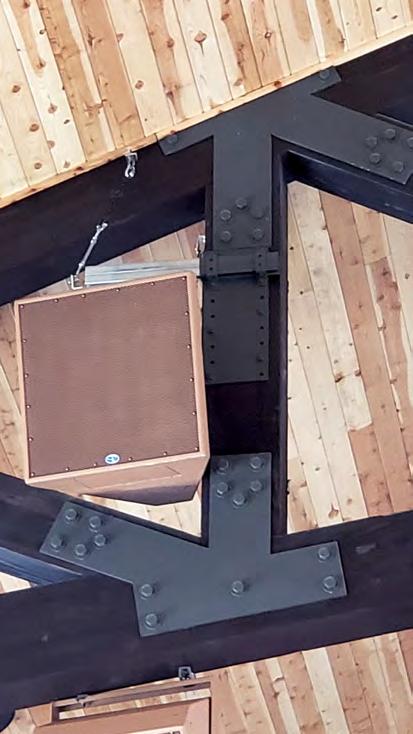

analysis of room acoustics and energy sources to understand the relationship between loudspeakers and the space and ensure optimal speech intelligibility as well as clarity for the reinforcement of musical instruments. Working with

the architect, Giannetta was able to provide data, including auralisation files that allowed the owner to hear various loudspeakers systems in tandem with different acoustical conditions. “Because of room geometry, potential loudspeaker locations and the need for room acoustics (RT around 2.1s) that are optimal for a Catholic church, we settled on a loudspeaker design using Danley loudspeakers, powered by Powersoft amplifiers,” explains Giannetta. “The Powersoft amplifiers allow for proper optimisation and protection for the speakers. Following installation of the system, we were really pleased with the results, even when the space isn’t occupied. We haven’t had any requests for adjustments to the system since it went online.”
Covid also presented unwelcome challenges for the installation process. As the facility is so large, sometimes there would be over 100 contractors working on the premises. “Despite the size of the building, with people working together they were inevitably getting sick,” adds Sweet. “At one point, the entire electrical team was forced offsite. In the early stages, there were three or four teams that were all missing and productivity ground to a screeching halt. Nothing was happening for weeks at a time. This delayed us in starting our work and everything slipped by over a year. Managing the delay was our biggest problem because we were committed to other work.”
In total, the audio setup at Saint Charles Borromeo uses 24 Danley, four Renkus-Heinz and eight
Soundtube speakers, powered by one Powersoft Ottocanali and five Quattrocanali amplifiers. In addition to the six main SH50 and SH60 units, the nave is supplemented by six SM100 and two SH95 cabinets. Two SM60F provide 60° x 60° coverage for upstage side-fill positions for the choir and ancillary seating and six THMini subwoofers provide low-end reinforcement (two for each transcept and two for the main nave). Completing the Danley setup are two SBH20LF-AT models that have been fitted outdoors for the massive patio area mounted left/right on large light poles. Two Renkus-Heinz CX41 speakers cover the large altar area, while four Soundtube CM 500i-WH and four SM 500i-II speakers have been fitted in the sacristy and narthex ceilings respectively.
A Xilica Solaro FR-1 provides open architecture DSP with 16 module slots, handling up to 64x64 bidirectional channels of audio over Dante, while digital audio mixing is courtesy of a Yamaha TF-1 console with 17 100mm motorised faders, 16 mic/line inputs and 40 input channels. One MIPRO ACT-848 Dante four-channel and one ACT828 dual-channel wideband digital wireless receivers have also been installed, along with two ACT80HC and four ACT-80TC wireless RF transmitters. The microphone setup consists of two FW730 choir microphones, one FM600 and one FMR500/HC ambo/cantor microphones from Earthworks; four Shure Beta58 vocal/instrument mics; and four PRA 628MKII
and four S214/u3 instrument microphones from Superlux. Three PTZOptics PTZ video cameras with an NDI interface and 20x lens allow the church to livestream their services.
“It isn’t a large, sophisticated video system,” explains Sweet, “in fact, it’s probably one of the simplest video systems I’ve ever installed. There are three cameras – located left, centre and right – and a computer and that’s really the extent of the hardware. And they very nearly decided against a streaming solution at all. They are streaming and recording their services but they felt that it wasn’t so important at this time to allocate a larger part of the budget to streaming.”
And perhaps rightly so. It’s a unique and impressive building design to serve the southern San Joaquin Valley for generations to come. In terms of audio, the chosen system had to provide intelligibility throughout such an expansive space. “The nearest pew to the preacher is about 14m away – that’s the nearest pew –and everything else after that is further away, with the back pews about 35m away. The speaker system – if you can do that one thing correctly – will get the highest quality results. If people don’t understand what’s being said, then all the rest is for nothing.”
PROJECTS
22 WORSHIP AVL July–August 2023
www.danleysoundlabs.com www.giadg.com www.powersoft.com www.spiderp.com www.stcharlesvisalia.org
None of the speakers were allowed to hang below the trussing
Spider Ranch Productions neatly fixed the speakers into the voids of the trussing
The outdoor Danley SBH20LF-AT speakers fitted to light poles
Unlock your Soundscape.
Hearing, seeing, feeling, connected. A new listening experience. Involvement with a most beautiful intensity. The interaction between artist and audience, more intimate than ever before. Enveloping sound reinforcement, succeeding so much more than right and left.
d&b Soundscape gives designers, engineers and artists the tools to create exceptional audience experiences.

dbsoundscape.com
 Photo: Tanner VonnahmeI, unsplash
Photo: Tanner VonnahmeI, unsplash
Smart listening
Listen Everywhere helps FVJC worshippers participate more fully in services
FARMINGTON VALLEY JEWISH Congregation (FVJC)-Emek Shalom, an intergenerational community of more than 250 families in Simsbury, Connecticut, has installed Listen Technologies’ audio over Wi-Fi assistive listening system, Listen Everywhere, in its temple. Members of the FVJC regularly gather at the temple for worship services, Jewish learning, social events and social action initiatives. Recently, the community expanded the audio settings for the sanctuary with a four-port audio output card. The expansion provided an output for an assistive listening system to help those with hearing loss and others in the FVJC community participate more fully in services and gatherings.

Mark Orenstein, the temple’s IT volunteer, had been involved in audio system upgrades at the Simsbury Library and the Eno Memorial Hall auditorium. The town had installed Listen Everywhere servers for audio over Wi-Fi assistive listening in those facilities and Orenstein

was familiar with the system’s performance. As a hearing aid user, Orenstein is an assistive listening technology advocate, as he knows the difference assistive listening systems can make for people with hearing loss.
FVJC installed a Listen Everywhere transmitter in its sanctuary so congregants can use
with headphones or earbuds. Congregants with Bluetoothenabled hearing aids or cochlear implants can access the audio directly from their smartphones.
“The new Listen Everywhere assistive listening system was easy to install and has helped

the audio and feel included and welcome in the FVJC worship services.”
The system also benefits people without hearing aids, as all congregants can download the app and access audio as needed. They do not need to borrow or return devices, although churches have the option to buy dedicated Listen Everywhere Wi-Fi receivers for users who do not have or prefer not to use a personal smartphone.
listening receivers. They download the free Listen Everywhere app, access the FVJC Wi-Fi network, stream live or recorded sanctuary audio to their smartphones and listen to clear sound
experience worship services and feel more included in their community,” says Orenstein. “We love the solution and continue to promote its use to ensure everyone knows they can access
“Farmington Valley Jewish Congregation-Emek Shalom is deeply committed to inclusion and creating a community where all are actively engaged and inspired,” adds Sam Nord, vice president of global sales at Listen Technologies. “Listen Technologies is proud to play a role in fostering connection within the community by making it easy for everyone to hear clearly and communicate in the sanctuary.”
www.listentech.com
24 WORSHIP AVL July–August 2023
PROJECTS
The LW-100P-02 delivers two channels of audio to audiences of up to 1,000 users
For an estimated 466 million people worldwide with hearing loss, traditional sound systems are not enough. Listen EVERYWHERE from Listen Technologies is a simple and affordable Wi-Fi streaming solution that allows people to use their smartphones for assistive listening.

Budget Friendly Listen EVERYWHERE is an affordable solution with options for every budget.


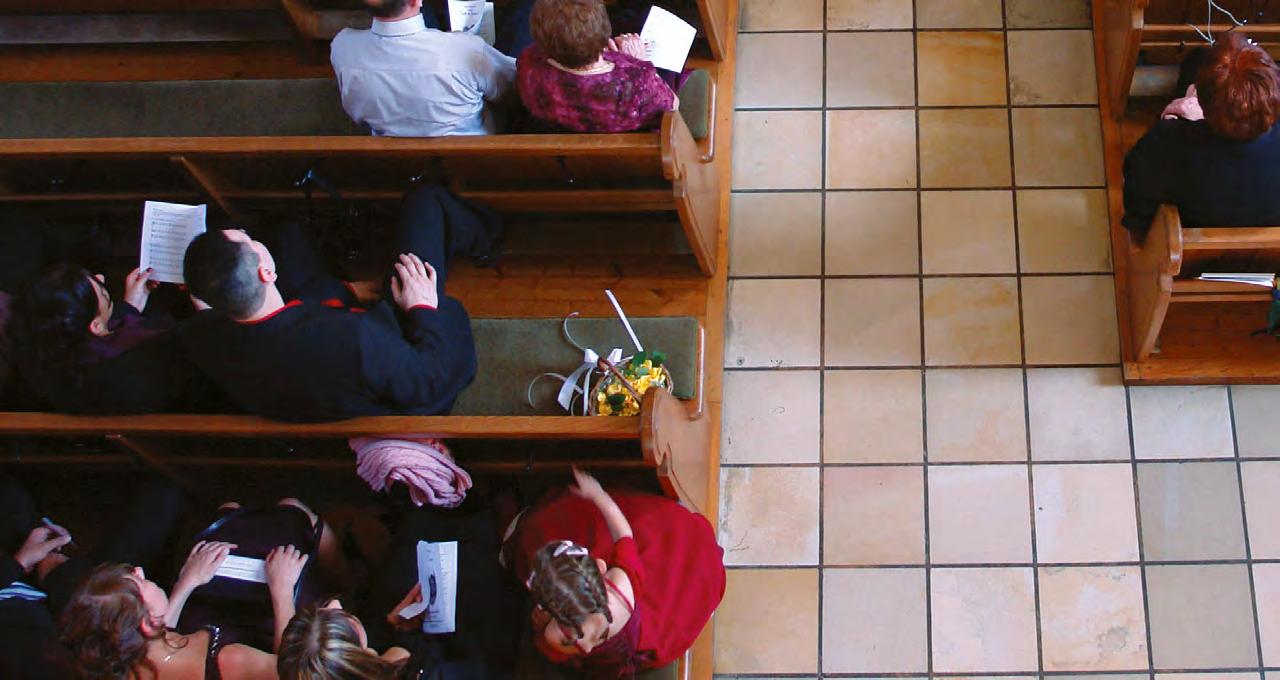
Bluetooth® Enabled

Connect to the audio using wireless headphones, earbuds, or hearing aids.
T-Coil Friendly Listen EVERYWHERE is compatible with t-coil enabled hearing aids and cochlear implants.
Listen EVERYWHERE
meaningful connections with your congregation when your audio is accessible to everyone using an audio over Wi-Fi assistive listening system. / / / / / / / / / / / / / / / / / / / / / / / / / / / / / / / / / / / / / / / / / / / / / / / FROM LISTEN TECHNOLOGIES Innovative Technology Stream audio over your existing Wi-Fi network using the latest technology.
No Latency No lip-sync issues! Low latency means the audio does not lag.
to Use
App, Fully brand and customize the free app with your colors, messages, and labels.
Create
Virtually
Easy
Customizable
Visit www.listentech.com/listen-everywhere to learn more or call +1.801.233.8992 for a free quote.
Did you know?
Singapore’s revamped national treasure revealed
Electro-Acoustics
NATIONAL TREASURES DESERVE constant attention and upkeep, but with age, their features need to be delicately preserved and maintained. Constructed over a six-year period in the early 20th century, Saint Joseph’s Church in Singapore serves as a good example. Numerous specialists including noted AV systems integrator Electro-Acoustics Systems (EAS) all played a part in elevating the church’s grandeur.
Having been listed as a national monument in 2005, the 111-year-old Roman Catholic church underwent intricate restoration works in 2017. The one-year mission to repair the stained-glass windows and decorate the roof was exasperated by architectural complications, National Heritage requirements and a certain Covid-19 pandemic. Located along Victoria Street within Singapore’s central business district, Saint Joseph’s Church drew experts from various disciplines to conduct
restoration works delicately and intricately.
Built in the form of a Latin cross, the church measures 66.25m long, with transepts of 45m and a nave that is 18.75m wide. Having made Singapore his home in 1999, Father Joe Lopez Carpio was welcomed by the community of St Joseph’s Church in July 2020. “This was a big restoration, and we are only one of 75 monuments to be gazetted here in Singapore,” shares Andalucian Father Joe.


“Following numerous meetings with consultants and architects, the extensive restorations covered absolutely everything inside and outside.” Originally booked in as a 12-month project, the expert restoration works including the 16m-high ceiling, the restoration of some 26,000 floor tiles and the original Belgian stained-glass windows would ultimately extend over five years.
L–R: Electro-Acoustics Systems’ Ng Soo Yee, Lam Tze Tze and Soh Jun Wei outside St Joseph’s

PROJECTS
Systems has helped 111-year-old Saint Joseph’s Church overcome speech intelligibility as part of extensive restoration works
26 WORSHIP AVL July–August 2023
Image courtesy of St Joseph’s Church
what the priest was saying from the altar. As such, the team decided to improve the audio quality in the middle of the restoration in 2020. That is when we commissioned EAS to help us with this problem.”


In their quest to provide an aesthetically pleasing, intelligible audio solution throughout the extensive sanctuary, the EAS engineers set about proposing a bespoke design using EASE




serving the naves. The Dantenetworkable, self-powered speakers receive their audio inputs from a Yamaha TF1 40-channel digital console located in the rear control room. DSP presets are stored within a QSC Core 110f digital signal processor, with the digital audio components routed through a Cisco 24-port PoE network switch.
Microphone inputs including Sennheiser ew 100 handheld and

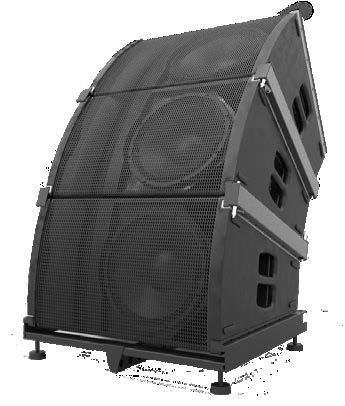

PROJECTS Build Up your Horizontal, Vertical, Down firing or Stacked Array, in 20° building Blocks ONE SLICE MANY POSSIBILITIES Seamless Transition Waveguide STW www.axiomproaudio.com
Smaller DC12/2 digital directivity control columns serve the naves
Father Joe Lopez Carpio delivers a sermon from the pulpit
Image courtesy of St Joseph’s Church
director Lam Tze Tze was conscious of the challenges that their engineers would face. “This church is one of the great landmarks here in Singapore, so we were fully aware that integrating the audio and visual technology in this monument was going to be very sensitive. From our experience, we knew the audio quality could be greatly improved in the newly restored church with the addition of Renkus-Heinz loudspeakers.”
The EASE modelling confirmed that the addition of two main L-R columns would be almost sufficient for the project. “The directivity is excellent, and the throw is sufficient all the way to the front entrance. In terms of aesthetics and blending in with the architecture, the speakers fit well into the building’s interior design. The enclosures have been painted in a custom RAL finish and the cabling is minimal, as the selfpowered speakers don’t require external amplification.”
Father Joe agrees with Lam.
“Ultimately, we are very happy from an aesthetics perspective that we only required four loudspeakers. The two main left-right columns together with two smaller models focused on the shorter naves are very accurate and provide even coverage. When you have a congregation of 1,000 people in a building like this with a ceiling that is 16m high, it is a challenge to create
such a volume, but the solution EAS provided achieves that.”
The pandemic coincided with the restoration works, so when the government in Singapore restricted services to a limited number of people, before determining that worship had to take place online in 2020, St Joseph’s turned to online streaming. “When I was assigned to this church in 2020, too many teams were online,” recalls Father Joe. “I prefer worshippers to come to the church in-person, but we also need to offer livestreaming should we ever need to. Although I prefer not to encourage the congregation to worship from home, we have integrated four cameras for livestreaming.”

The HD signals from the three Datavideo PTC HD PTZ cameras together with a Datavideo BC-80 3G/HD block camera are streamed to an SE-2850-8 eight-channel digital video switcher. HDMI signals are output to both an internal network of Samsung HD screens and monitors in addition to the YouTube platform. A Kramer 1:2 HDMI distribution amplifier together with 4K60 4:2:0 HDMI transmitters and receivers ensure the digital signals are broadcast over the HDBaseT infrastructure. The addition of a Datavideo NVS-25 video encoder and MP4 recorder promotes simultaneous livestreaming and recording in the H.264 format.
“Today, most churches require livestreaming for worshippers who cannot physically attend the service to be able to attend remotely,” Lam acknowledges. “In addition, the church can also use the cameras for recording purposes, so it futureproofs the application should there be a need to stream internally and wish to expand on this as an alternative. With restrictions lifting, most people are entering into houses of worship, but streaming is here to stay.”

A simple outdoor audio system consists of 12 Tannoy DVS 8-inch surface loudspeakers powered by a single Lab Gruppen E10:4

four-channel amplifier in 100V line operation. Wireless microphones can be used courtesy of the seven Winegard FlatWave Air digital outdoor antennas that have been installed in the grounds. Finally, a breakout room combines dual Sennheiser ew 100 handheld wireless microphones fed into an Ashly MX-206 six-input stereo mixer and output to dual QSC K8.2 active 8-inch speakers.
With Covid restrictions lifted, the reopening of the newly restored neo-Gothic building 110 years after its consecration in 1912, allowed 800 guests to attend a dedication mass in 2022. The occasion marked a new era for the church and one of satisfaction for EAS. “Heritage works require a lot of considerations to be made, so we need to engage in a lot more communication in advance,” Lam extends. “It’s standard now for installing an AV system that can deliver intelligible speech and HD streaming does not interfere with an interior design. However, the stakes are a lot higher in a heritage building.” Having celebrated its 40th anniversary recently, EAS has consistently demonstrated the utmost attention to detail. This makes them a Singaporean national treasure of their own within the southeast Asian AV community.
www.easpl.com.sg
www.sjcvs.org.sg
PROJECTS
28 WORSHIP AVL July–August 2023
Video streaming is enabled with the addition of Datavideo PTC HD PTZ cameras
A Sennheiser gooseneck ensures audio clarity for Father Joe Image courtesy of St Joseph’s Church
A pair of Renkus-Heinz Iconyx IC16-RD steerable column speakers provide intelligible audio throughout St Joesph’s
THE NEXT BIG THING

Horizontal Dispersion
SPL of 138 dB
Balanced
Max
out more at www.dasaudio.com
Find
Designing for intelligibility
Acoustic ambience of this nature renders a pleasant lingering and enveloping nature to voices engaged in chanting or choral singing. Unfortunately, however, it has a degrading effect on the intelligibility of the spoken word, reducing the clarity of words/sentences. The longer the reverberation time, the greater the difficulty experienced in comprehending speech.
THE SCIENCE BEHIND designing for intelligibility has been developing for many years. Of late, however, it seems that marketing departments have discovered the word “intelligible” and apply it liberally. I don’t understand how a small point source loudspeaker attracts the description of “highly intelligible” but it happens.
Intelligibility in a given space depends on so many different features of the sound system, including but by no means limited to 1) the number of loudspeakers, 2) the directivity of the loudspeakers, especially in the voice register and 3) the level of background noise and the loudspeaker’s ability to deliver a good signal-to-noise ratio as well as the regular fidelity and coverage items.
One recent example that I worked on is an Australian Greek Orthodox church which featured four regular plastic 12-inch cabinets which


generically deliver 90° x 40° dispersion in the treble register. Typically, such loudspeakers exhibit little or no control of sound dispersion in the male voice register because the male voice register is reproduced almost entirely by the 12-inch woofer or large loudspeaker in the cabinet, whereas the horn in the top of the cabinet only reproduces treble well above the male voice.
When the building underwent significant refurbishment, including a re-paint and air conditioning modernisation, an upgrade of the sound system was added to the work. The original manual/analogue controls were replaced with modern AV system controls and the loudspeaker system was renovated to provide more intelligible speech across the listening area. The building itself exhibits difficult acoustic ambience in the male and female voice registers at around 2.5s reverberation time mid-band.
Replacement loudspeakers were designed to better control the voice register dispersion in the form of a 4m-high line arrays. Each array consists of eight groups of four small loudspeakers controlled by eight channels of digitally processed signals run through eight separate amplifier channels. There is an interesting issue to overcome with such loudspeakers. The array, being vertical, actually compresses the vertical dispersion of sound while maintaining a wide dispersion across the horizontal plane. The trouble is that this is a linear effect whereby a 2m-high array might compress the vertical dispersion to 2° at say 2kHz where a lot of consonant energy resides, but it will have to be 20m high to maintain the same control at 200Hz or male voice register. Such a change in dispersion is treated by 1) only sending treble register sound signals to the central segments of the array and 2) arranging the signal processing in the lower register to electronically steer the sound towards the floor/ seating area. The treble register is steered downwards by tilting the array forwards at the top by 3–4°. The result of all this signal processing is vertical dispersion confined to the listening audience across the range of speech in an optimised manner. By avoiding upper parts of the walls and ceiling, the aim is to deliver greater clarity of the spoken word.
Proof of concept was undertaken by creating a 3D model of the church in EASE 4.4 software and adjusting the surface materials to replicate not only the building shape but also the building’s acoustic ambience. The old sound system’s performance in respect of intelligibility was measured in a number of locations
and the entire arrangement optimised for best performance. It is worth pausing here to discuss intelligibility. Speech Transmission Index (STI) is a measure of how well a listener might comprehend the spoken word. It is usually measured using a process called STIPA running on specially programmed test equipment such as NTi’s XL-2 and MR Pro. It does not absolve the designer/installer from the need to ensure the system’s frequency response or sound level from bass to treble is evenly dispersed. It is in fact another layer on top of all the usual requirements for good sound system design.
So how did the design process measure up? Firstly, it is worth
KnowHOW
Peter Patrick, senior consultant at Noise Measurement Services, considers how intelligibility can often be the least understood measure in audio system design
30 WORSHIP AVL July–August 2023
Intelligibility issues have been overcome at an Australian Greek Orthodox church
The old speakers needed renovating to provide more intelligible audio
reviewing the meaning of STI numbers. The STI scale runs from 0 for impossible to comprehend to 1.0 for perfect results. The listener’s chances of comprehending the spoken word for STI ratings in the range of 0.3 to 0.45 are “poor”. Readings from 0.45 to 0.6 mean chances are “fair” and above 0.6 there is a “good” chance the listener will fully comprehend the spoken word.
In most cases, the installed loudspeakers delivered slightly better results than predicted. In all cases, speech intelligibility is improved – in some cases by a large margin and others less so but in all cases an improvement is seen and heard.


There are interesting points to note regarding the design. 1) The building and main listening area is much wider than deep. This means that a line of smaller loudspeakers down each side of the building will never deliver the required outcome because there will be insufficient clear energy reaching the centre seats.

The church was modelled using EASE 4.4 software
loudspeaker and all loudspeakers also relates to the width of the building. The sound from the opposite loudspeaker arrives here after a significant delay and is loud enough to degrade intelligibility.
3) While the delivered intelligibility is a worthy improvement for speech and



sermons, it has the reverse effect on chanting/choral singing. To overcome this issue, a separate signal path was implemented which is controlled by a feature on the system control interface to direct the appropriate microphone signals only to the

uppermost portion of the arrays. The result is sound emanating from the uppermost location in the building enhanced by the building’s natural reverberation for a natural lingering and enveloping ambience. We now have a result where announcements are much more easily understood by the congregation but choral work/chanting retains the natural ambience.
Intelligibility isn’t as well understood by the general mass of integrators as this author would like. The STI measure might have been developed in academia but the instruments to measure it are readily available and so too is software to predict it, as are text books describing the design process. NTi’s STIPA is a measure of how well a listener is likely to comprehend the spoken word. What, after all, is the value of chest thumping bass and paint stripping volume if the words are incomprehensible?
SI SERIES P10 und S210

VERSATILE INSTALLATION TOOLS
With the new SI SERIES HK Audio has unveiled a family of speakers tailored to meet the needs of today’s installation market.
The two new S210 V and S210 P subwoofers complement the P10 column speakers in the low-frequency range. For use in particularly demanding outdoor environments, both the P10 and S210 P are tested and certified with IP 66 protection class.
The combination of dustproof as well as water proof mid/high unit and subwoofer is unique worldwide and delivers uncompromising audio quality even under the most difficult environmental conditions. Certified ingress protection class IP 66 (EN 60529, applies to P10 and S210 P) Certified
It can be seen that the new system delivered an STI of 0.64 in say row 2 seat 6. The individual main loudspeaker facing that location delivered an STI approaching 0.75 when run without any other speakers in operation. Note here that the difference in STI between one
KnowHOW July–August 2023 WORSHIP AVL 31
PROFESSIONAL
hkaudio.com hkaudio.com hkaudio.com hkaudio.com
(DIN
P10i/j TR: 100/70 V transformer, 3 power taps (150 W max.), 125 dB SPL (10 % THD) P10i/j: low impedance (16 ohms), 300 W (RMS), 128 dB SPL (10 % THD)
for voice alarm (EN
Extensive mounting accessories for walls, ceilings and for flown installations HK_Audio_SI-SERIES_Anzeige_2022_Family_en_160x139.indd 1 10.05.22 08:51
ball impact proof
18032-3)
Certified
54-24:2008)
The new speakers avoid upper parts of the walls and ceiling and deliver greater clarity of the spoken word
Dramatic displays without drama
Consumer televisions are now a viable option for house of worship displays, says Key Digital VP of product education and experience, Jonathon Ferry, who also offers solutions for overcoming the limitations of HDMI interconnections for content distribution

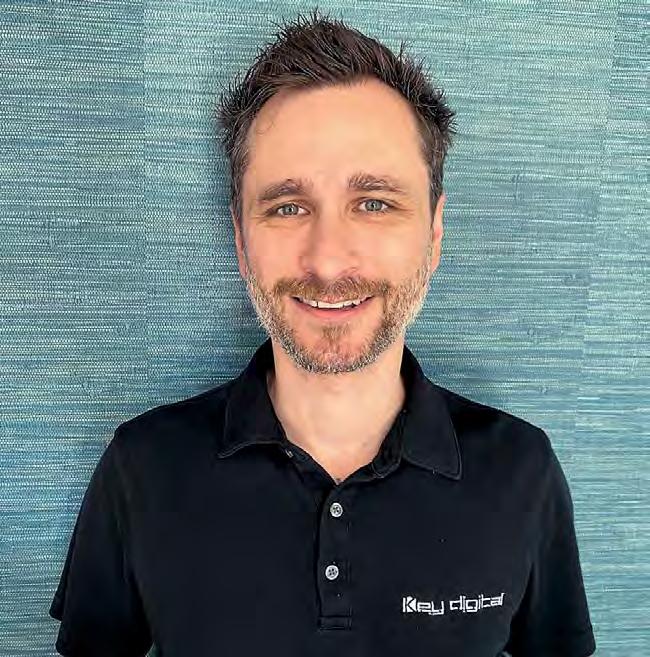
HIGH-RESOLUTION CONSUMER
televisions now serve an important role in houses of worship. Thanks to the combination of increased capability and connectivity with decreased form factor and price point, budget-friendly 4K displays are now used for tasks such as IMAG, song lyric and scripture display during services, and for announcements or mood-setting images during the congregation’s walk-in time. In addition, HOWs are using televisions as displays in cry rooms, overflow seating and lobby and entry area digital signage.
But how can a church dynamically distribute centrally fed video and audio to each of these locations, and how can the worship tech staff easily control the displays and routing of the video signals?

Of course, most consumer displays include at least one USB port which may be easily used for digital signage content by “sneaker net” – walking preloaded USB memory drives to the monitor location and plugging them in for
play in a loop. The issues raised by that use case include time-
content to the various television locations at 4K, and even at 1080p
Dedicated videowall processors can turn
100m, and signal repeaters can be used for longer distance runs. With the data density of high-resolution video, particularly with 4K video, HDMI extender devices will often have shorter maximum extension lengths. There are scores of HDMI/Cat extenders on the market with various extension distance capabilities and additional features. Extender transmitter/receiver sets offered for various resolutions and applications by Key Digital provide extensions of 40m to the full range of 100m over a single Cat cable. Beyond mere extension, our devices also offer advanced capability, such as downconversion of 4K signals to 1080p for legacy displays (including projectors), video switchers at the transmitter, extension of IR remote and RS-232 control, audio de-embedding to feed
32 WORSHIP AVL July–August 2023
Jonathon Ferry
audio amplifiers and control via portable devices or IP.




For all videowall displays, processing is required to split the image into pieces. There are purpose-built videowall LED displays on the market but, once again, these displays often have a price-prohibitive cost. Often, HOWs wish to use a videowall as a large-format display, maintaining 16:9 aspect ratio and not requiring 24/7 run-time. Dedicated videowall processors like our KD-VW4x4ProK can be used with four consumer displays for effective videowalls thanks to ever-narrowing display bezels and a well-thought-out feature set in the videowall processor. Users can assign a single input to all four displays, divided and assigned accordingly, or send any input to any display, creating a grid of separate or repeated images. While bezels around television screens are getting thinner, the image processing can compensate for what visible line bezels do create between the screens, minimising impact for the viewer. If the bottom bezel of a display is wider than the top and sides, as is frequently the case, no problem – flip the


on the network is driven from the gigabit switch, with an HDMI output to feed the display. The result is a matrix of sources and destinations where any source can be assigned to any display.
Encoders and decoders can often be powered over Ethernet via the Cat cabling connection (the same goes for extender receivers and transmitters – power one with the power supply and power the other over Cat), which simplifies installation. Where the displays are beyond the range of Cat/Ethernet length limits, the IP signal can be boosted with another network switch. With an AV-over-IP system, a facility’s digital signage displays, overflow seating areas, a speaker’s confidence monitor on the rear wall of the sanctuary, a cry room and videowall monitor arrays can all be independently fed with any source desired. Where encoders and decoders have videowall capabilities, arrays can be configured from as many monitors as desired and a source fed to all, or to individual displays or clusters of displays. Control doesn’t even have be centralised – for instance, the full system control from an iPad connected by Wi-Fi
top displays upside down so the conjoined centre bezels are thinner and uniform, and let the video processor flip the assigned images by 180°.


A networked AV-over-IP system offers maximum flexibility in source routing and control. Such systems encode connected sources for IP (Ethernet-style) network delivery to displays via a networked decoder for each display. Using our company’s AV-over-IP systems as an example, each video source – a camera mixer output, a computer for playback or other HDMI sources – would have an assigned encoder that injects the IP encoded signal into the network through Cat cabling and a managed gigabit network switch. A dedicated decoder for each display
to the network and running control software like our free, end userfriendly KD App. With no knowledge of a complex programming language, presets and friendly control GUIs can be created that allow a full system setup to be recalled for a service with a few swipes and taps of a screen. With IR, IP and RS-232 control, the remote displays can be turned on and off without touching the device or a handheld remote (and no worries if a remote is lost). By applying solutions ranging from simple HDMI signal and control extension to a full AVover-IP networked system, distant source and screen connection is a Cat cable away.
environment
etcconnect.com etcconnect.com/Halcyon
www.keydigital.com visual
technologies
four consumer monitors into a videowall
Simplifying console programming
AS A LIGHTING DESIGNER AND technician working with student volunteers on a daily basis, I spend quite a bit of time programming my consoles so that a student technician is able to easily walk up and establish lighting looks effectively and with as little hassle as possible. As lighting rigs have seen an increase in the quantity of automated and/or LED instruments – even in very small, lower-budget facilities – the quantity of control channels and programming possibilities with these rigs has increased seemingly exponentially. Even control consoles have become dramatically more powerful, while at the same time coming in form factors available for every budget, from fullsize desk to PC control software and gadgets. It is important that systems be set up and maintained in such a manner that technicians feel the system is accessible and empowers them as they serve the production needs of the event or service.
In this article, I’m going to discuss a few tips and techniques that I have found to be useful when programming my consoles for my volunteer technicians. To my knowledge, all of these tips and techniques can be applied to any modern control console, regardless of form factor. I won’t get into the specific programming syntax as that is dependent on your console, but I will discuss concepts that you will be able to use and, if unsure, you will be able to find in the manual of your console. Most of these tips and techniques pertain to programming that is done before cuing sequences for worship service elements. These lay the foundation and are the building blocks when programming cue sequences, which I will touch on at the end. So let’s dive in.
It all starts with the patch
Have you ever asked for a certain instrument to be turned “on” that should be controlled by a certain channel and, when the channel
intensity is brought up, nothing happens? Or, in the absence of a channel sheet, have you had to test out channels one by one in order to find a particular instrument in the rig? Patching, one of the very first steps of programming your console as well as the starting point for any troubleshooting, is an organisational tool that can be used to help you easily navigate the rig. Patching assigns a circuit or instrument address to a control channel, allowing you to manipulate whatever controllable parameters exist for that device.
In addition to making sure all of the appropriate paperwork exists for documenting the rig’s patch, I like to organise my console channels logically in case I don’t have the paperwork in front of me. Usually, I will patch my console either by “focus position” or “purpose”. Some people will patch by instrument type, for example keeping all of the Chauvet Maverick MK2 Spot units together. I don’t follow this method and will explain why later in this article. Keep in mind that a channel may control a single device or a number of devices. Therefore, my standard patch looks something like this in all of my venues (I recommend being consistent with your methodology if you have several facilities that volunteers move between):
Channel 1–10: house lighting zones
Channel 11–15: front-light stage apron (zones 1–5)
Channel 16–20: front-light midstage (zones 6–10)
Channel 21–25: front-light up-stage (zones 11–15)
Channel 31–35: back-light stage apron (zones 1–5)
Channel 36–40: back-light midstage (zones 6–10)
Channel 41–45: back-light up-stage (zones 11–15)

Channel 51–55: side-fill stage apron (zones 1–5)
Channel 56–60: side-fill mid-stage (zones 6–10)
Channel 61–65: side-fill up-stage (zones 11–15)
Channel 71–75: down-stage specials
And so forth. Organising my channels in this way helps my volunteers to be able to find individual channel control efficiently and without too much guesswork. There is no “right” or “wrong” organisational method to use – this is just what I have found to be the most effective in my situation.
Groups and palettes
If you haven’t ever used groups and palettes for programming before, you really should become acquainted with them. In terms of pre-programming, I spend the majority of my time building
groups and palettes for quick recall of almost anything I want to be recallable. This saves huge amounts of time, particularly if your rig has a large quantity of automated or LED instruments. Groups record combinations of channels for easy and quick selection. Palettes record data for a single parameter of multi-parameter instruments.
The first thing that I program after patching are groups. I mentioned this earlier in the section on patching. For example, I have 32 automated LED wash units in one of my facilities. I find that I often want to grab all 32 instruments at the same time, but it can be cumbersome to grab 32 channels
individually. Instead, I have a group set up that selects all of those channels in one command. I also have groups for the full stage front lighting, all apron zones, all midstage zones, all up-stage zones, etc. Any grouping of channels that I think I may want or need to control all together frequently will get programmed in this way.
I then move on to programming my palettes. I often begin with colour palettes because I use colour palettes all the time as I have a large quantity of LED colour-mixing instruments. I will program a colour palette for any colour that I may want to use over and over again. My colour palette library is quite large in that when I need a new colour that I hadn’t

KnowHOW
John Black discusses the importance of setting up consoles so that volunteers feel that they are accessible and easy to use
34 WORSHIP AVL July–August 2023
MA Lighting grandMA3 – colour palettes
MA Lighting grandMA3 – position palettes
previously programmed, I add it as a new palette so that it can be recallable if someone asks, “Do you remember that colour you used for that event last month? Can we use that again?” Storing colours in the palette memories means that I don’t have to remember the RGBWA values for each colour mix.
I then move on to position palettes because I have a large number of automated instruments. These instruments allow the operator to adjust the pan and tilt from the console to focus the light beam on different parts of the stage or auditorium. I create a position palette (or focus palette) for any position that I think will be used during an event over and over (or that may change depending on stage setup). For example, if lighting a band, I will create a position palette for each major member of the band, as well as some aerial fan-outs and other specialised positions for “looks” I want to use.

Beam palettes can be created to control and recall any of the beam parameters in an instrument, such as pattern selection, iris, animation, effects slot, etc. These are especially useful when you have automated profile, spot or beam instruments in your rig as you can then quickly recall that information for specific effects or aerial looks you want to reuse.
It is also possible to create intensity palettes for multi-parameter instruments, but I don’t find that I use intensity palettes very often.
The benefit of using these palettes when cueing is three-fold. First, by referencing palettes when building cues, presets or other memories, it saves you a lot of programming time because you are recalling intensity, colour, position, beam and other data that you have already pre-programmed rather than dialing all of that information in for every instrument for every cue. You can reference a palette as many times as you like.
Second, by referencing palettes, if you need to make a change across your whole show, it may be possible to just update the palette being referenced and the change will be reflected through all of the cues that reference that palette. The best example of this lies in regard to
position palettes. If you have a palette that points instruments to where the drum kit is set up, but then the kit actually gets set up a metre or so out-of-position, all you need to do is update the focus palette for the drum kit and all of the cues lighting the drummer will be updated to the new position information in the palette.
Third, palettes can empower and make working with volunteer technicians much more efficient. It is a lot easier to ask a volunteer to “grab all of the Mac 700s, focus them on the lead singer, colour them magenta and add pattern 3”, rather than asking them to do that one by one, instrument by instrument. Using palettes, this can be accomplished in only four or five steps.
Console magic sheets
If you are fortunate enough to have a console that integrates digital magic sheets, this can be an invaluable tool in working with your rig both for yourself and your volunteers. It adds an even more user-friendly programming layer in that once created, a digital magic sheet allows the operator to select and work with instruments, groups, palettes and other parameters through a graphical user interface.
Setting up magic sheets can take some time and you will need to


experiment with the format that is most useful for your situation.
If desired, you could create a completely digital, controllable version of your lighting rig. This may be impractical, however, if your rig is quite large and would require extensive scrolling. Instead, think of the magic sheet as a customised touchscreen controller for controlling groupings of instruments and their parameters quickly and easily. You may have individual instrument control for any specials you may have set up, but otherwise you may have a single button mapped for each instrument group or each palette in a particular show.

The way that I implement magic sheets into my events is as a method for simplifying the palette and group libraries I have for what is actively set up in the grid. For example, I have a show file that I continually merge all of my palette information into. There are many palettes in that file that are unused in a particular event. Instead of scrolling through lists of palettes during programming, I will create a magic sheet for only those commands that I need access to for a particular event. It simplifies access to these settings without getting rid of the entire library of memories.
Conclusion
As mentioned earlier, all of this programming happens before recording cues or other playback memories for an event. However, the more that I program ahead of time as groups or palettes, the faster the programming process will be. Not only that, but your volunteers will be able to create complicated lighting looks with ease, empowering them to be a part of the creative process with minimal upfront training. Happy programming.

KnowHOW July–August 2023 WORSHIP AVL 35
ETC EOS – digital magic sheet
MA Lighting grandMA3 – beam and gobo palettes
installation specialists and systems integrators to cover multiple applications with a single amplifier platform family which would create consistency across different applications, with an emphasis on simplicity, longevity and effectiveness. It would offer easy
failure while allowing more accurate reproduction and improved performance over previous models, which the manufacturer puts down to its higher signal-to-noise ratio. An all-new power supply section facilitates efficient conversion, resulting in less power being
via three Ethernet ports, allowing both Dante redundancy and splitting control vs AoIP traffic. Power sharing capabilities have been upgraded from existing Powersoft products, with each output channel capable of delivering up to twice the power when loaded
extends Unica’s capabilities and allows users to store and access projects and monitor systems remotely, as well as perform updates, without the need for any programming or activation. It can be integrated into third-party systems and provides an intuitive dashboard for an in-depth overview of all Unica-powered installations without any additional hardware. Universo is able to inspect the signal flow of any input or speaker within the audio system and offers full sites history (including ongoing and Ultimately, Unica is well-positioned for the current AV climate: simplifying installation, maintenance and integration of other products while reducing energy consumption. “It will allow systems integrators to easily build and monitor a system, as well as giving their clients services that they haven’t been able to offer, or have offered with very limited functionality,” sums up Giorgi. “In this way, they can save time in implementing the service, opening up more features when it comes to maintenance and spending less time on configuring the system and making sure it fits the specific application.”

www.powersoft.com

36 WORSHIP AVL July–August 2023
Luca Giorgi presents Unica to the press and partners at ISE 2023
Akira Mochimaru
Powersoft is promising a “one-size-fits-all” solution with its next-generation Unica amplifier platform, targeting multiple applications in medium-to-large installations with the ability to integrate diverse products and functionality







 Active Audio an Arbane Groupe brand
Active Audio an Arbane Groupe brand
Video switching
one in our CrossWalk Conference Center and I use it to play images for our centre screen); one SDI converted to HDMI feed from our broadcast control room upstairs; and one HDMI cable that is for visiting laptops or other video peripherals that may be needed
The little Roland works perfectly for switching between those four sources and it even allows me to have audio-follow-video (AFV) so that as the user switches sources, the embedded audio follows the video switch. That is important because they need audio from the video cart to feed an input on their audio console. Having AFV just simplifies the operation, reduces error count and reduces the learning curve for this design. It
even has a multiviewer output with audio level indicators. There are a ton of features built into that Roland operational menu that I was quite impressed with all it can do for the price. But I would never want to switch a Sunday service on it.
Medium switchers
I would classify the Blackmagic Design ATEM 2 M/E a medium switcher simply because it has 20 inputs and two mix effect rows. These switchers can be integrated with actual physical switchers made by Blackmagic, which almost makes them, and can in some configurations, large switchers. But the basic soft switcher is medium.
VIDEO SWITCHERS HAVE always been cool to me, even as a kid. Especially as a kid. I have always liked the way they look and what they do. At my church, I work with several types and sizes of video switchers; in this article, I’d like to describe each one that you’re likely to encounter in a worship environment.
Small switchers
Sometimes you aren’t producing a “show”, but you still need to switch sources occasionally. That is where I have deployed a small four-input HDMI switcher in our choir room. The worship leaders came to me wanting to upgrade the video capabilities there, as well as to migrate all the video assets into one location. The setup used to be that some video was integrated into the audio cart and they didn’t like that. So, I designed a 7m-high rack with everything I knew they needed to date, as well as some growth space for years down the road. Knowing the budget for this project was not going to be huge, I tried to limit it to US$2,000. A Roland V-1HD video switcher fit that budget very well and it had all the inputs I need: one rack Mac Mini for ProPresenter; one rackmounted BluRay player with the ability to play SD cards and USB drives (I have
I have one in our Crosswalk Conference Center and in our main broadcast control room that I am using to build a larger streaming operation for Sunday services. If you like switching on a touchscreen computer or a keyboard with shortcuts and a mouse, then this would be suitable.

Our Crosswalk Conference Center, at its largest configuration, had eight cameras and a multitude of other inputs that were needed for regular Sunday services when we had a “contemporary” service there for many years before combining it with our “traditional” service a year ago. Now, I have it mainly configured for the many different needs that it has as strictly a conference centre. I have only four cameras full-time (one main camera, two robos and a centre-mounted wide angle from the catwalk above the stage that shows the stage and the audience). The rest of my sources are things like ProPresenter audience and stage inputs, BluRay player (as described in the choir room setup), HDMI connections for visiting presenter laptops or for our laptop as a video source, fibre feed from the main Worship Center, etc.
One of the main benefits of this switcher to me is that it has multiple aux outputs that function as a router. For instance, I have an aux output for our centre screen, one for the hallway IMAG TVs, one for the confidence projector, another
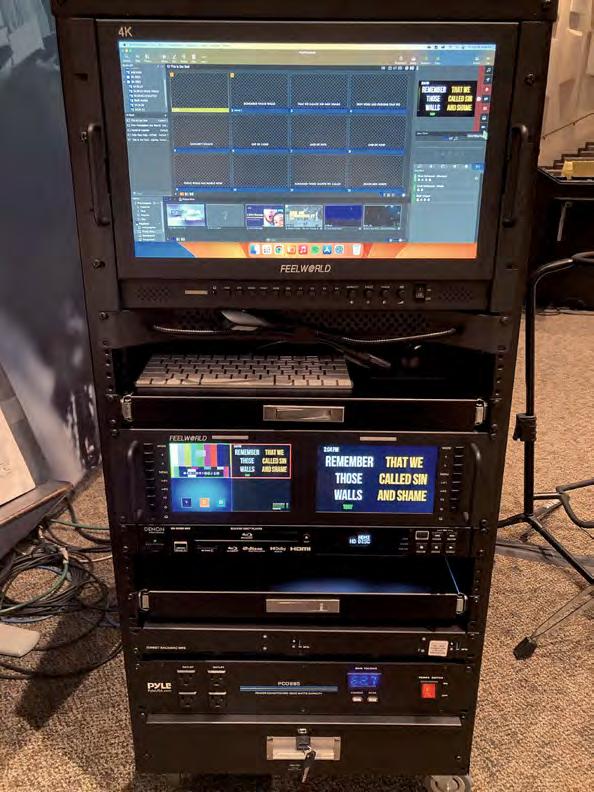
TECHNOLOGY 38 WORSHIP AVL July–August 2023
Our Roland switcher in the choir room
California and later at Green Acres in Tyler, he spent the past 25 years in broadcast television working for multiple television stations in the US. He has worked as a broadcast technician for a major telecoms company, managing national and international television broadcast signals over a switched fibre optic network. He also owned and operated an independent video production firm in Tulsa, Oklahoma for 10 years before returning to Tyler in 2016.
Casey Hawkins
for the TVs in our café, one for a big monitor in our downstairs control room – and they are all destinations that I can feed with any source I have in the ATEM switcher. The next best thing is that I can save and recall preset configurations. We have a Wednesday evening Bible study class and the needs for that event are unlike any other event we have in there. But with the use of presets, I can change the routing of all the aux outputs, the actual input configuration, nomenclature of inputs and outputs, key configurations, the Supersource configuration and even the layout of the built-in multiviewers (there is one for each M/E). This saves a lot of configuration time each week and reduces the learning curve for people managing the event. Then, with the click of a mouse, I can restore everything to the way we need it for all other events. The Supersource is a feature of the switcher that acts almost as another M/E because you can layer video over video. I use it to key a video source over my camera shot that essentially creates an OTS (over the shoulder) box shot like in the news.
Blackmagic has truly built a great system of products that get even better when you match them with other Blackmagic products. If you have one of their HyperDeck SDD recorders, which we do, then you can remotely operate that from the switcher panel and start and stop recording your event, no matter where the recorder is on your LAN. If you have their cameras (we don’t), then through a fibre configuration,
you can control your cameras’ shading and colour effects and facilitate your comms needs with headsets, tally and more. That is another way this can mimic a large switcher configuration. But again, without the 4 M/E configuration and a physical switcher panel, I would not want to switch a Sunday service on this soft switcher in its standard format. I just prefer the feel and touch of switcher buttons and T-bar.
Large switchers
These are going to be the kind of switchers you find in commercial
video applications like TV stations, other large churches and production trucks. They are built to remain powered on for years, have exceptional up-time and reliability, and integrate with other high-end peripherals such as an SDI router. We have a couple of Ross Carbonite switchers in our Worship Center. They offer built-in multiviewers as well as the other two I have described in this article. They have aux outputs as in the Blackmagic ATEM. I use presets with these as well but, because they are intended to exist with other major systems like routers, they don’t have some
of the features that the Roland or Blackmagic ATEM do, simply because the intended user most likely wouldn’t use those types of features. These are less of an “all-purpose” switcher and more of a specific use switcher. I am very comfortable switching Sunday services on these switchers. However, for the average person, the operations of these can be very complex.
Our Carbonites are used to switch live for in-room IMAG, livestream and post-produced TV programmes. We have thousands in attendance each Sunday, on livestream outlets and on television. Therefore, we cannot have any downtime anywhere in our system. These Ross Carbonites are built to be up to that task. We can customise our multiviewers, inputs and outputs (all tied to our master SDI router made by Harris), media storage “still store” channels and DVE effects. By using their software, you can configure these switchers at a high-end professional level. It is more of a “standard”, or “manual”, transmission in a car or truck. You must make many more decisions setting these up than the medium and small switchers.
If you need a video switcher for any reason, know that there are many kinds of them on the market today, ranging from small to large, with varying capabilities, quality and, of course, price. Figure out your needs and find the right one for you.
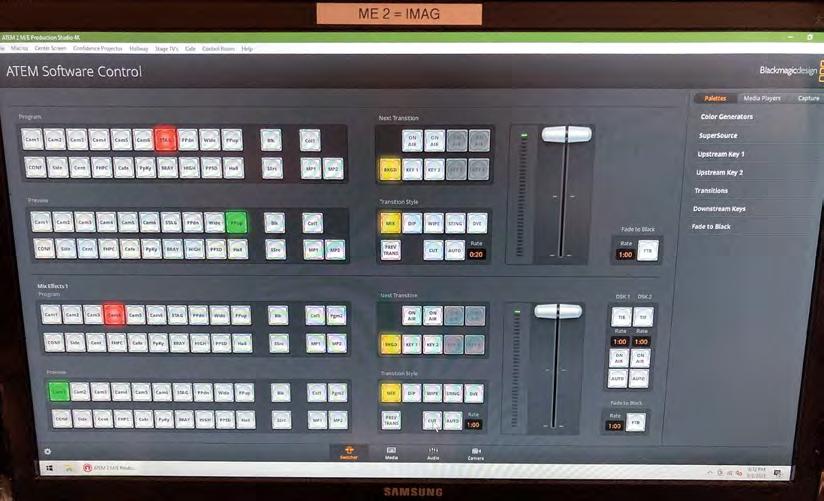
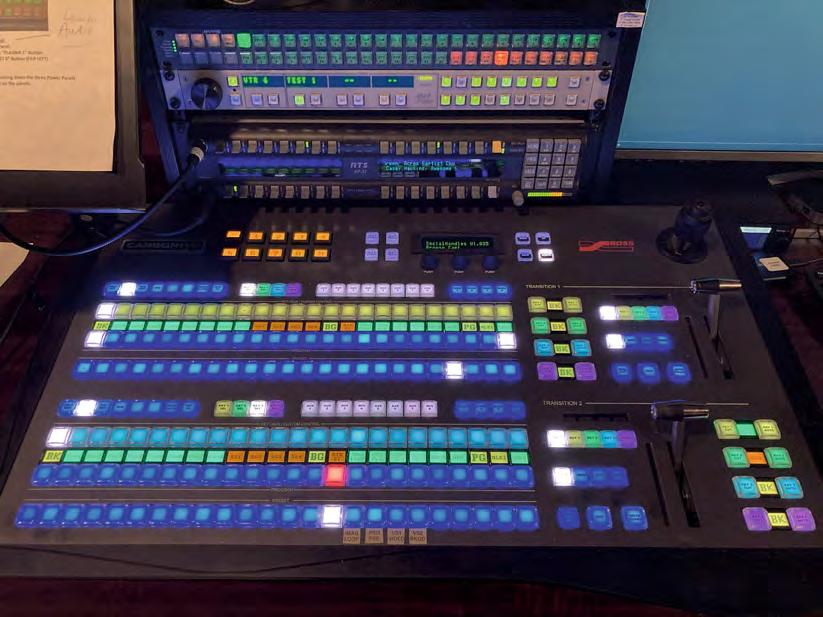
TECHNOLOGY July–August 2023 WORSHIP AVL 39
A Ross Carbonite switcher in the Worship Center
Our ATEM switcher in the CrossWalk Center
Integrating pixel LEDs into a DMX lighting system
Luke Gaschk, customer success engineer at Advatek Lighting, looks at how pixel LEDs can be integrated into a DMX lighting system


MY FIRST EXPERIENCE OF using a lighting system was an old DMX controller, with a large number of halogen multipars connected to a dimmer rack. Technology has come a long way since then, with the introduction of LEDs, moving heads, lasers and many different kinds of eyecandy fixtures. If you’ve ever thought about how you could add some new elements to your lighting system, but didn’t want to break the bank, then integrating pixel LEDs into your design could be just what you’re looking for. You might have seen pixel LEDs in stage lighting but didn’t even notice that’s what they were. Pixels are becoming more and more common, and can be found in many places, including highlighting stage edging, bringing together a set backdrop, creating RGB star cloths, illuminating spaces like a foyer or even creating high-precision house lighting.
What’s a pixel LED?
A pixel is simply a cluster of LEDs mounted in a very small space, with
a chip that controls the intensity of each LED. Typically, there are three LEDs (red, green and blue) so that RGB colour mixing can be used. These three LEDs are often integrated into a single LED package, which then effectively creates a very small “pixel”, which can be set to any colour you like. Place many of these
pixels together in an installation, and now you have the capacity to create unique and precise effects by mapping the pixels in software. The simplest example of this effect is a long line of pixels in the format of a strip. The strip could be mounted across the front edge of the stage or along the edge
of a wall, and you could create chasing effects with any colour combinations you like. Another example might be a videowall, where a two-dimensional plane is covered in pixels. You could then create interesting plasma effects or bounce colours across the pixels. From here, there is no limit on how pixels could be creatively installed. Think of pixels as the building blocks to your installation; you decide the arrangement!
How does it all work?
From a technical perspective, pixels themselves are connected in a sequential chain. There are DC power lines, as well as data lines. The first chip in the chain receives its data signal and decodes this to determine how much to turn on each of its LEDs. It then passes the data onto the next chip. The data signal used to communicate with the chips is passed in series between each of them, rather than connected in parallel to all chips in a run. This is different to
TECHNOLOGY 40 WORSHIP AVL July–August 2023
Pixel LED controllers can manage enough power to light up a dramatic stage show Image courtesy of Bespoke Lighting and Video
Pixel LEDs powered by Advatek PixLite A4-S Mk3 controllers are used to highlight stage edging at a Coldplay concert
Image courtesy of GO LIVE PRODUCTIONS
DMX (which is what standard stage lights normally use for data), as it means that each pixel doesn’t need to be individually addressed, which saves on setup time, and there isn’t a limit of 512 bytes of information on a single run of data, which means you can have much longer runs of pixels, beyond a single universe.
There are sometimes additional data wires, which are typically either a clock line or a backup data line. The clock line helps to increase the speed of transmission, which can be beneficial
if refresh rates are of concern. The backup data line is helpful for creating redundancy in the series data transmission which otherwise is prone to a single point failure in any chip.
But how do I get the pixels do work?
With all this in mind, you might be asking, how on earth could I control these pixels? Well, this is where the pixel controller steps in. The pixel controller understands what language
each type of pixel needs, so it is the one responsible for outputting the data signal to the pixels themselves. The controller is often also responsible for managing power to the pixels, in the form of fault protection, voltage and current monitoring, and providing fuses to protect against over-current.
In a typical stage environment, live data is streamed to the controller from a sending source, typically a lighting console or computer software. This live data is then processed by the controller and sent out to the pixels. The live data is often in the form of DMX over Ethernet (usually Art-Net or sACN). This is becoming more readily available in lighting consoles themselves but, if your console doesn’t support this, there are many options for lighting software that can do this for you.

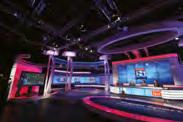

The benefit of DMX over Ethernet is that a large volume of data can be sent out via a standard network cable, and be received by multiple pixel controllers. It also means that the overall refresh rate can surpass the standard 44fps by which DMX is usually limited. However, even if you choose to use DMX as a source of live data to connect to the pixel controller, there are options to support this.
In many situations, live data might not be ideal. Think of situations

where there is a standalone set piece onstage, offstage or even in a church foyer. For these types of installations, it would be best to have the pixel controller send out its data to the pixels without the need for a computer to generate this data.
A pixel controller that can record live data for later playback, like Advatek’s A4-S Mk3, can be very useful for this type of installation. You can connect the controller to a computer to program it with effects that look great for its purpose, and then unplug the Ethernet cable and playback these effects later without the data source connected. You could even create triggers to playback different recorded effects when you need to, which could be driven by a traditional DMX source, such as your lighting console or a DMX wall controller.
The way that pixels can be integrated and controlled is rapidly growing, which gives so much more opportunity for inspired lighting designs. Throughout all the designs I’ve seen, the ones that seem to stand out are those that use pixels in new and creative ways. It’s a simple integration to bring pixels into a DMX lighting system, but it can truly elevate a design to be much more effective than before.
www.advateklights.com



The team at DWR Distribution look forward to assisting you with the sale of sound, staging, rigging, power, audiovisual and lighting equipment, backed up with advice and great service.







TECHNOLOGY July–August 2023 WORSHIP AVL 41 DWR Distribution, Block C, Unit 1, Kimbult Industrial Park, 9 Zeiss Road, Laserpark, Honeydew, 2170, Johannesburg, South Africa • Tel: +27 11 794 5023 • Fax: +27 11 794 5702 • www.dwrdistribution.co.za
We also
Looking for a professional audio visual solution? Stage and Touring • Theatre and TV Studios • Events and Leisure Discotheques and Clubs • Architectural Lighting • Worship • Schools
offer professional installation services.
A PixLite A4-S Mk3 powers a turn-key modular LED solution at a Keith Urban concert Image courtesy of GO LIVE PRODUCTIONS
PRODUCT SPOTLIGHT
additions to its iSeries range and launched the FOOTSIE “footlights” fixture. The IP65-rated FOOTSIE is available in two standard lengths, the FOOTSIE1 (600mm) and FOOTSIE2 (1,200mm), with a choice of warm or tuneable white LEDs or RGBW high-power, singlechip LEDs. The classic warm white LEDs offer a CRI greater than 90 for key lighting of faces, and the tuneable white ranges from 2,700–6,500K. The RGBW version facilitates all colours and LEDs are evenly spaced to provide smooth washes and continuous runs of illumination across stages, sets and runways. At just 52mm high, the FOOTSIE keeps stage and sightlines clear and clean, while an integral self-contained cable tray can be used to neatly run any loose laying audio, power or data cables. For flexibility on a run of fixtures, the FOOTSIE1 has two individually controlled zones within its 600mm length, while the FOOTSIE2 has four zones. Robe’s BluMark allows a low-level blue LED indication of the stage edges without affecting lighting states, while an integrated shield covers line-of-sight between the LED sources from the audience side and can either be folded inside the fixture housing or released and installed in position.
ESPRITE product. Maintaining identical aesthetics, output and features, it reportedly ensures seamless integration between the two models. To maintain a consistently high lumen output, water, dirt, dust, haze and smoke are repelled from the front lens with Robe’s ParCoat hydrophobic, oleophobic-resistant coating which allows easy cleaning/ removal without scratching or damage.
The iPAINTE is an IP65-rated short/medium-throw profile luminaire that retains the qualities and features of the PAINTE indoor version, and both products’ identical footprint and DMX map mean they can be integrated within the same lighting rig. Ingress protection allows onsite maintenance with no additional tools, while the onboard and patented RAINS (Robe Automatic Ingress Neutralization System) manages
pressure control. Also joining the iSeries range is
indoor Tetra2 with the added benefit of Robe’s RAINS ingress protection technology. The unit also runs automatic self-tests and provides an error message if it detects any issues.

Finally, Robe’s LEDBeam 350 is now weatherproof in the form of the iBeam 35, which maintains LEDBeam 350 features and has an identical footprint and DMX map to its forebear.

In addition, Robe’s RoboSpot follow spot system has utilised the RDMNet protocol to allow it to be used on IP networks. Device discovery, settings and operations can be performed directly between the Robe RoboSpot system and Robe fixtures, eliminating the need for other equipment like splitters or nodes.

42 WORSHIP AVL July–August 2023
www.robe.cz
iPAINTE
iTetra2
FOOTSIE
Don’t just hear it. Hear it right.
You’ve heard us amplify with perfect clarity. You’ve heard us in standing ovations. You’ve even felt us, in the standing hair on your arms. And now, get ready to experience all the ways we deliver honest sound. meyersound.com

Yamaha unveils DM3 with Dante-compatible and non-Dante versions
Yamaha has added the DM3 series of digital mixers to its professional audio lineup

WITH BOTH Dante-compatible and non-Dante models available, the DM3 consoles are suitable for a wide range of applications. Offering up to 96kHz sound quality, a fast and simple setup and ease of operation, the chassis measures 320mm x 140mm x 455 mm and weighs 6.5kg.
There are two DM3 mixers in the series – the DM3, which features Dante audio networking for quick and flexible connection to a wide range of compatible audio devices, and the DM3 Standard without Dante. Other than Dante provision, the features on both models are identical – 16 mono, one stereo and two FX Return input mixing channels, plus six Mix Send, two FX Send, one stereo and two matrix output mixing channels.
Offering low latency and two highquality processors featuring 18 types of effects, a simple, intuitive user interface is centred around a large, 9-inch screen with multitouch control. Users can choose from multiple languages for channel names (using the DM3 Editor or DM3
StageMix applications) displayed on a light or dark background, reportedly making the DM3 series easy to use in any space, lighting conditions and by users of different nationalities. The DM3 is also ideal as a sub-mixer for a Dante-compatible main console. Additional features include custom fader banks, MonitorMix support for personal monitor mixing and an 18-in/18-out USB audio interface. Multitrack recording via USB to Host is supported, while simple two-track recording is also possible using a USB memory stick and a separate USB connector on the front panel. The Dante-capable DM3 adds further multitrack recording capability using Dante Virtual Soundcard. Meanwhile, the DAW Remote function means a range of DAWs can be controlled from the console. Recordings can then be edited with the bundled Cubase AI software or a different DAW.
DM3 consoles include all the features needed for high-quality streaming. With stereo and matrices, the audio routing allows the creation of separate mixes for onsite and streaming sound.

In terms of fixed installations, both consoles support OSC and MIDI (via USB) general-purpose external control protocols and User Account, User Defined Key and Custom Fader Bank can be used to configure settings for users. The consoles are compatible with Yamaha’s ProVisionaire software suite, which allows the creation of bespoke control panels, tailored to the needs of remote control and installation monitoring. Meanwhile, the optional RK-DM3 can be used to mount either unit in 13U of a standard 19-inch equipment rack.
Additional software applications include DM3 Editor, a standalone Windows or Mac application for both online operation and offline setup and editing, and DM3
StageMix, an iPad app that enables remote control of the DM3 Series via a simple, intuitive interface, allowing an engineer to control mix parameters from a performer’s position on the stage. Meanwhile, the MonitorMix application for iOS and Android devices puts control of each performer’s monitor mix in their hands.
www.yamaha.com/proaudio
Adamson Virtual Fletcher Machine 54 Dante AV 4K-T and 4K-R 56 log Way 8-HDMI input card 54 kmagic Design Videohub 12G 56 meo OTOS SP6 / OTOS B5 57 aypaky Skylos / Arolla Aqua 57 DA Audio SPACE by CODA 46 GiCo Quantum852 53 DDK4000 51 NTX 210L 46 X5 and IP Bar 1000 57 HH Electronics TNi-W12PRO / TNi-W8PRO 48 NDI|HX3 option for KY-PZ510N 55 K-array Lyzard-KZ1 I and -KZ14 I 46 AR GF42 / GF162 47 ing & Freitag PIA LFX 50 ystems MAUI 28 G3 and 11 G3 47 rtin Audio TORUS 8 49 yer Sound 2100-LFC / MPS-488X 48 trik NL4FXX / NL2FXX 54 XO ePS12 / eLS18 47 ZOptics Move SE 55 RCF NX 915-SMA 50 Renkus-Heinz UBX Series 48 RØDE NT1 5th Generation 51 Roland VR- 6HD 56 Ross Video Carbonite Ultra 60 55 Sennheiser EW- DP 52 Shure GLX-D + Dual Band 52 TOA IP-A1AF 50 Yamaha DM3 44 AV • LIGHTING • LIVE SOUND • INSTALLATION • BROADCAST • RECORDING
A–ZCONTENTS
44 WORSHIP AVL July–August 2023
COMPACT POWERFUL VERSATILE

The JBL A6 dual 6.5-inch passive line array element represents the performance and features you’ve come to expect from the VTX family of products. It’s a versatile, low-profile solution for anything from small applications to supplementing arena-scale systems.








• All-new JBL transducers





• Innovative two-way design
• 110° horizontal coverage

• Full-range response down to 68 Hz
• Efficient passive crossover network allows 16 speakers per amplifier*





• Common VTX auto-locking rigging system
• Light weight (18.4 kg/40.3 lbs)
*using Crown I-Tech 4x3500HD amplifier
536 mm / 21.1 in 190 mm / 7.5 in
Make SPACE for CODA
SPACE BY CODA combines AV technology with art to create an audiovisual experience that is scalable and adaptable to any environment –and where the mechanics of what is a concert-grade audio experience are rendered completely invisible. The system can be used to create an environment of any type or nature or it can be integrated into existing environments.
SPACE by CODA integrates immersive 3D audio, a 4K projector screen, ambient lighting and acoustical treatment with a choice of art or projection into a united system solution to transform spaces with audio. The result is the SPACE Panel. At just 70mm deep, SPACE Panels can reportedly offer sound quality and performance surpassing that of conventionally designed (cabinet) loudspeakers. This driver-equipped canvas can transform spaces to feature invisible audio, enabling high-quality, full-range sound in previously limitative environments.

“Instafit” magnetic waveguides native to the SPACE audio modules facilitate production of directable sound with the capability for immersive audio. Sound diffusors and acoustic treatments may be interleaved between loudspeaker modules for better control over sound
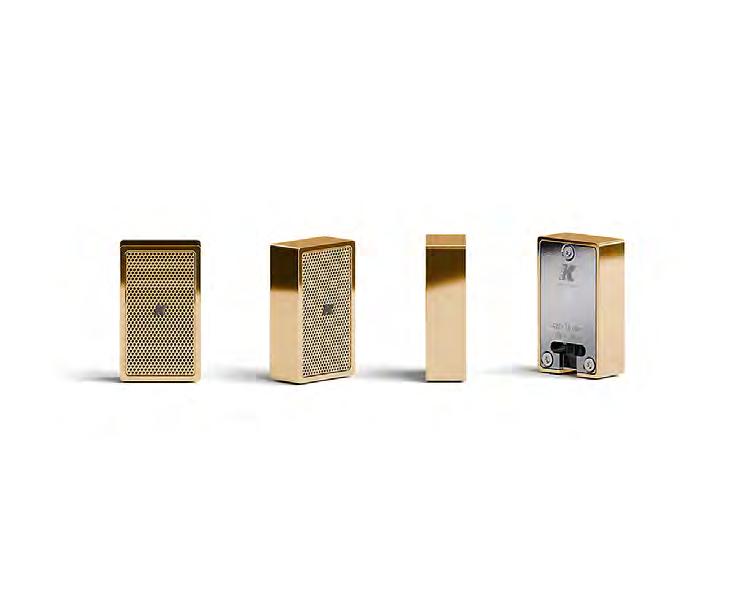
sensor-controlled sub-bass modules can be deployed to deliver even lower frequencies to concert sound proportions. Matching CODA LINUS DSP amplifiers complete the package. The addition of the SPACE Hub processor opens up the possibility for true 3D immersive audio.
The loudspeaker modules and diffusor/acoustic panels are arranged and connected like building blocks –and then completely hidden behind an acoustically transparent 4K projector screen – or a SPACE Art highresolution digital canvas print. SPACE Panels can be arranged in any ratio, size or custom orientation to create a modern, borderless panel that will enhance any environment. They can even be mounted on the ceiling.

EAW builds on Radius line of speakers
The SPACE by CODA system consists of three ultra-flat immersive loudspeaker modules – the M1, M2 and M4 – which allow each screen to be built in 600mm increments. The M1 measures 600mm x 600mm x 70mm for distances up to 10m; the M2 is 1,200mm x 600mm x 70mm so
double the size and double the SPL (+6dB) for distances up to 18m; and the M4 measures 1,200mm x 1,200mm x 70mm, so four times the size and four times the SPL (+12dB) for distances up to 25m.
All loudspeaker modules include 10-inch passive radiators for LF, 6.5-inch MF drivers and 1.75-inch HF drivers with “instafit” interchangeable waveguides for optimum directivity control. Each module achieves a frequency response range from 45Hz–
21kHz, with a maximum SPL of 121dB (A weighted) for the M1 module and up to 137dB SPL (A weighted) for the M4. The MF/HF sections are rotatable to enable both horizontal and vertical plane steering.
www.codaaudio.com
K-array counts calories
FEATURING
OPTILOGIC
technology, the NTX210L from EAW is said to provide effortless array optimisation to get users up and running faster and with fewer opportunities for error, as each array communicates with surrounding modules using proximity sensors. Resolution 2 software provides system optimisation from anywhere in the venue, plus intuitive room design and prediction in a single, comprehensive application, while the Isophasic waveguide ensures each array provides pristine sound to every seat. The NTX210L additionally boasts 1,600W of power to satisfy
large audiences in a medium-format, compact system.
The speaker and its accessories have been designed to support medium and large outdoor events, houses of worship and other live venues. It has a frequency response of 55HZ–18kHz and has a maximum SPL of 140dB. DynO Dynamic Optimization actively tracks input spectrum and power delivery, continually maximising output and fidelity at any drive level. Other features include integrated Dante networking (with loop-thru), including analogue redundancy capability.

www.eaw.com
ceilings. A wide range of colours and metallic finishes ensure that all Lyzard models blend into any décor.
for outdoor and indoor installations.
www.k-array.com
46 WORSHIP AVL July–August 2023 PRODUCTS
Lyzard-KZ1 I
KGEAR extends its GF family
WITH THE compact
the GM44 analogue audio matrix, KGEAR by K-array has reinforced its GF family. Despite featuring 2-inch drivers that are common to the existing GF22 and GF82 models, the GF42 and GF162 column enclosures vary in terms of throw and dispersion angle options. Featuring a built-in amplifier with auto On/Off with the added ability to drive a passive speaker, KGEAR has released active versions – the GF22A, GF42A and GF82A – of the three existing models. In addition, 70V/100V versions – the GF42T, GF82T and GF162T – are also available for large-scale loudspeaker deployments. Designed to provide greater flexibility of installation and a cleaner aesthetic, the GF

connector sealing cap accessories, promoting their use for outdoor applications.
The GM44L is a four-zone analogue audio matrix featuring four stereo line inputs with gain control, four stereo line outputs with treble and
that can be independently assigned to each zone output and mixed to the selected input channel. A dry contact input can mute all inputs except the priority auxiliary input for emergency purposes. Five link outputs correspond to each one
LD Systems elevates MAUI to G3 status
WITH THE introduction of the MAUI G3 Series, LD Systems has updated its compact column PA system with a host of new features.
The third generation of MAUI loudspeakers is based on a revised subwoofer concept with four bass-reflex ports and an enlarged speaker chassis that incorporates the Class D amplifier. Capable of producing a total output of 1,030W RMS and 730W RMS for the for the MAUI 28 G3 and MAUI 11 G3 models respectively, both column PA systems provide full range audio characteristics.
Equipped with a 12-inch and dual 8-inch woofers, the MAUI 28 G3 and MAUI 11 incorporate DynX DSP generation for extending
and reproducing low frequencies down to 37Hz (MAUI 28 G3) or 39Hz (MAUI 11 G3). When using a second subwoofer, the bass range can be operated in cardioid configuration via a pre-set.
The two aluminium column elements are designed as cardioid speakers to provide controlled low-mids to the front and up to 18dB of attenuation to the rear.
Consisting of 12 (MAUI 28 G3) and six (MAUI 11 G3) 3.5-inch centre drivers, phase plugs placed in front and two 1-inch tweeters coupled to a BEM-optimised waveguide, both models offer even coverage of 120° x 30° horizontally across the listening plane. Complete with Bluetooth 5.0 and AAC coding, the
interconnected. Up to four GA201s can be mounted in a 1U frame with the G-RACKMINI2 accessory and all signal connections incorporate 3.5mm stereo jacks.
www.kgear.it
MAUI G3 offers playback from a wireless content source.
The manufacturer has also unveiled QUESTRA, the newest design and management software for networked LD Systems installation solutions. QUESTRA enables access to the full DSP capabilities of all LD Systems’ audio installation devices, allowing users to configure audio networks of any size and manage and control every device from a single application. The software also includes an editor to create custom user panels for remote control that can be operated from Windows computers or any Android or iOS portable device.
www.ld-systems.com
NEXO expands ePS installation speaker range



NEXO HAS added the ePS12 and eLS18 sub to its ePS Series launched in 2021. The ePS12 combines a 12-inch neodymium long-
offering dispersion options to the user, a peak SPL at 1m of 133dB and a frequency response at –6dB of 60Hz–20kHz. The ePS12 can be
with the eLS18 18-inch sub which shares the same design aesthetic and extends the LF response down to 32Hz. Dedicated accessories allow ePS cabinets to be flown beneath the subwoofer, creating small-footprint wideband systems that are described as visually pleasing. Both cabinets are minimally fitted with a hard-wired strip for connection, offering two 7mm pitch in/out screw connectors. The IP cover protects the connectors from moisture in outdoor
applications. On each side of the cabinet, two M6 with 80mm pitch and one M10 fitting allow connection to a U-bracket, bumper or eye bolts. The back of each speaker is fitted with three M6 with 70mm pitch for wall mount in both horizontal and vertical positions. The eLS18 features two 7mm pitch in/out screws connectors and M10 rigging points. The units are finished in black structural paint (white and all other RAL colours are available to order), with a UV-resistant acoustic fabric stretched over the front grille.
www.nexo.sa.com
July–August 2023 WORSHIP AVL 47 PRODUCTS
GF42
MAUI 11 G3
The ePS family
Meyer Sound unveils 21-inch low-frequency element
THE 2100-LFC low-frequency control element has been introduced by Meyer Sound, extending the technology of the Panther largeformat linear line array loudspeaker down to the lowest limits of audibility. By pairing a Class-D amplifier with a single, new 21-inch driver with four voice coils, the 2100-LFC subwoofer is capable of producing a linear acoustic output suitable for demanding applications. With an extended



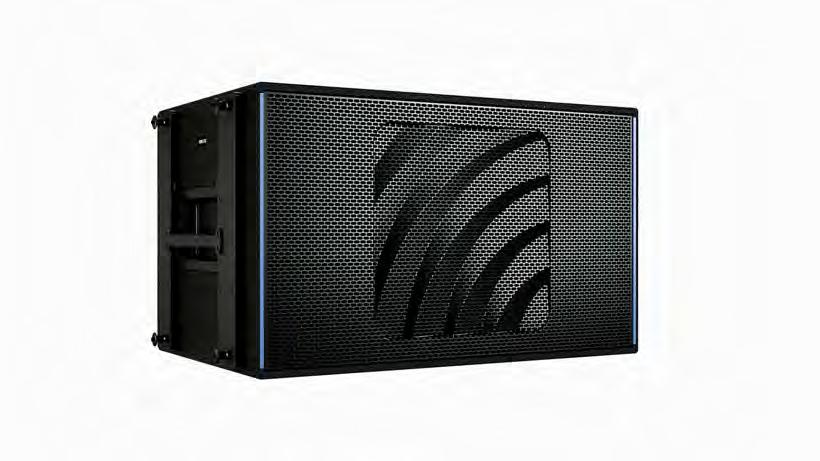
powering over a single composite cable, the MPS-488X combines the sonic superiority of self-powered loudspeakers with the installation ease of low-voltage systems. Each MPS-488X supplies eight channels of power and balanced audio signals. The MPS-488X incorporates a network connection as standard, with telemetry and control data accessed via an RJ45 connector on the rear panel. Critical data such as load status, current draw, fan speed and
Renkus-Heinz embarks on a passive drive
WITH THE UBX Series, RenkusHeinz beam-steering technology can now be obtained in passive column arrays. Unique for the UBX Series, Passive UniBeam Technology addresses each transducer with specially designed all-pass filter networks and gain sharing. Reportedly delivering consistent front-to-back coverage with minimal side-lobe artefacts, the inclusion of additional frequency filtering generates an asymmetrical vertical dispersion with constant directivity. The incorporation of neodymium 3-inch full-range drivers contributes to the compact 111mm x 121mm (WxD) dimensions of all three models. Weighing between 4.4kg and 13.6kg, the UBX4, UBX8 and UBX12 columns comprise four, eight and 12 3-inch drivers respectively. Registering a horizontal dispersion of 120° below 5kHz, vertical coverage varies between 15° and 30°
Available in black or white, the aluminium cabinet can be plumb surface-mounted courtesy of the included W-Wall UBX bracket. In addition to the inclusion of audio transformers for 70V/100V constant
voltage operation in large, distributed audio systems, all UBX Series models are weather resistant to an IP64 rating with a gland nut protected input cover.
www.renkus-heinz.com
the 1100-LFC product. For the new driver, the Meyer Sound engineering team built on the experience gained from the dual voice coil 18-inch driver in the 900-LFC, but stepped up to four voice coils. The amplifier is rated at 1,200W maximum continuous power, with peak power of 8,000W. The frequency and phase response of the 2100-LFC is tailored to complement not only Panther but the entirety of the manufacturer’s linear line array products, making it a fit for customers who already own 900-LFC or 750-LFC products and want to expand their inventory.
Reducing the weight and size of the cabinet is said to aid flexibility as productions are faster to rig and easier to fly in a wider range of venues. This flexibility also allows users to bring high levels of low-end performance to even the smallest venues.
A new integrated power supply and signal distribution unit for multichannel audio systems that utilises the company’s IntelligentDC technology has also been released. By delivering both balanced audio signals and 48V DC for loudspeakers
to assess the status of connected loudspeakers. The Nebra platform also allows the operator to mute or solo individual channels of the MPS - 488X
Unlike its predecessor, the MPS488HP, network connectivity on the MPS-488X doesn’t require the use of an external RMServer device. However, for mixed system compatibility, both the MPS-488X and MPS-488HP with RMServer can report their status on the same Nebra interface. Designed principally for installed sound applications, the MPS-488X utilises three-pin Phoenix connectors for balanced audio input and five-pin Phoenix connectors for audio and DC power output. It also features a new two-way Wink mode, which allows for identification of the unit when multiple units are in a rack. Pressing a button on the unit identifies it in Nebra while clicking on it in Nebra winks an LED on the unit. In addition, a Safe Mode facilitates troubleshooting while a Restore option allows resetting to the original factory settings.
www.meyersound.com
HH Electronics doubles up for TNi-WPRO
PURPOSE-DESIGNED FOR small and medium-sized applications, UK-based HH Electronics has launched two versions of its TNi-WPRO installation loudspeakers. The TNi-W12PRO features a 12-inch high-power, lowfrequency driver with a 2.5-inch voice coil and a 1.4-inch Celestion CDX11445 highfrequency driver.
Meanwhile, the smaller TNi-W8PRO features an 8-inch high-power, low-frequency driver with a 2-inch voice coil and a 1-inch Celestion CDX1-1070 highfrequency driver.
Designed for a wide range of environments, both models have rotatable waveguides for vertical or horizontal dispersion with 90° x 60° coverage to enable precise control of the soundfield. TNiWPRO speakers feature all-wood enclosures with input connection options via either M4 barrier strip or Euroblock. Mounting options include seven M10 Penn-Elcom fly points and four M8 mounting points for optional mounting with a TNI-BRK30 bracket. Both models are available in black or white.
www.hhelectronics.com
48 WORSHIP AVL July–August 2023 PRODUCTS
2100-LFC
Martin Audio adds to TORUS Series
ceilings, a horizontal centre cluster may also be a practical
The T820 provides a defined 100° x 20° coverage pattern from a compact enclosure that weighs 14kg. Its small size and portability are said to extend its range of applications from live sound and permanent installations to musicians and other events. A phase plug is mounted in front of an 8-inch neodymium driver to increase mid-band sensitivity, while two 1-inch exit, 1.4-inch voice coil high-temperature polymer dome neodymium compression
compromised, even when driven
suitable for installation and touring applications and supports up to six cabinets in vertical or horizontal array configurations. It can also be teamed with the SXCF115 cardioid subwoofer, which features a forward-facing 15-inch driver and a 12-inch rearfacing driver capable of 137dB peak.


the T1215 and T1230, Martin Audio has unveiled a smaller addition to the series, TORUS 8 (or T820 as the individual model is known). The T820 is a passive, two-way loudspeaker
been designed as an array element in vertical constant curvature arrays as well as being used singly as a point source loudspeaker. In venues with short throws yet high

The TORUS 8 comes in a plywood cabinet, finished in hardwearing PU paint and incorporates two pocket handles for easy installation and deployment, as well as fixings for pole-mounting. Rigging hardware and accessories are
The TORUS 8 features two NL4 connectors with passive configuration using pins 1+/1– or 2+/2–, selected via a rear-mounted switch, and the systems are powered by Martin Audio iKON amplifiers, which support VU-NET control software and Dante integration. The TORUS 8 also features an LED indicator that can be illuminated via VU-NET software to identify its location on the network. Systems can be modelled in 3D with optimising filters to deliver consistent and defined coverage, using DISPLAY 3 software.
www.martin-audio.com



July–August 2023 WORSHIP AVL 49 PRODUCTS
Pro Audiovisual & Entertainment Lighting Technologies Exhibition and Conference for the Growing Southeast Asia Markets www.prointegrationfuture.asia/ @Pro Integration Future Asia Connect with Us: Marina Bay Sands Expo & Convention Centre 26 to 28 June 2023 Monday to Wednesday
MARK THE DATES TODAY Join PIFA2023 to discover the boundless possibilities in the development of this ever-changing industry and engage the industry professionals, government agencies and start-ups Meet over 6,000 brands and integrators showcasing advanced AVL technologies Discover more than 100 key vertical markets such as education, enterprises and more! Connect with communities from 15
Pro
Integration Future Asia 2023 (PIFA2023) is an inaugural international trade show crafted for audiovisual and entertainment lighting suppliers and specialists to deliver real-world application showcases to multiple vertical markets in Southeast Asia.
Kling & Freitag extends PIA with LFX
KLING & Freitag has extended the line sources of the PIA family with the PIA LFX. Denoting “Low Frequency Extension”, the loudspeaker corresponds to a PIA M in dimensional size and shape but is equipped with six 4-inch woofers in a bass-reflex chamber that extend the low-frequency response of a PIA M to approximately 50Hz. The PIA LFX has a nominal power handling of 100W, a program power handling of 200W and a nominal impedance of 8Ω. The speaker comes with speakON NL4 (1+/1–) and Phoenix connectors.
The PIA LFX low-frequency extension can be mounted on an M20 thread using the latest accessories and is compatible with any M20 base plate or subwoofer. A connector enables a PIA M to be mounted on a PIA LFX in just a few simple steps. Long mixed line systems consisting of PIA M and PIA LFX can also be built. Sharing the same dimensions, existing PIA M accessories in addition to existing cases can also be applied. One channel of a K&F system power amplifier is required to operate the PIA LFX. The PIA LFX is compatible with K&F’s PLM+ and D-Series along with the IPX 1200 and IPX 2400.

www.kling-freitag.com
THE NX 915-SMA and NX 912-SMA from RCF are stage monitors designed for musicians and bands. The combination of a 1.75-inch compression driver, 15-inch woofer (12-inch for the NX 912-SMA), two-channel 2,100W amplifier and the TRW waveguide is said to produce coherent 100° x 70° coverage for the listening area with up to 131dB SPL (130dB for the NX 912-SMA) of distortion-free sound. It can be used as a stage monitor, standalone speaker system or satellite paired with
a subwoofer. The NX 915-SMA combines the manufacturer’s proprietary FiRPHASE and Bass Motion Control DSP processing to deliver “absolute clarity and deep, powerful bass response”. The tour-ready, rugged, all-wood cabinet is described as easy to carry and set up onstage or on a pole.
RCF has released its DMA 504 four-channel Class-D matrix amplifier. Equipped with what the company describes as a powerful DSP platform, the DMA 504
TOA extends its emergency credentials over IP
CAPABLE OF decoding IP audio streams into analogue audio signals, TOA has added a PoE-powered audio interface to its catalogue. The IPA1AF is equipped with an integrated 15W amplifier to drive low-impedance speakers and internal memory, capable of storing up to 20 audio files, although an external amplifier can also be connected to the analogue audio and control outputs. Capable of receiving broadcasts from Video Management Systems via ONVIF backchannel, device control is accessed through remote API (HTTP) or local control inputs. The PoE-powered Gateway Unit integrates multiple IP audio devices by converting the SIP voice or ONVIF backchannel audio into multicast audio streaming and the IP-A1AF can also transmit built-in sound sources or input audio as multicast audio streaming.
Equipped with a built-in 8W amplifier and internal data storage for up to 20 audio files, the IP-A1PC238 and IP-A1PC580R are PoE-powered ceiling speakers. Both models support the SIP protocol for integrations with VoIP
devices and come with 20 available multicast ports for group paging operations. Boasting the same features, the IP-A1PC580S is a PoEpowered surface-mount speaker. Connection to the VMS network via a single LAN cable and assigned an IP address, the IP-A1SC15 can combine both video and audio systems. Live announcements or pre-recorded messages can be prioritised for broadcast during emergency situations with one of four different audio broadcasting modes (SIP Direct Call, Multicast
manages inputs and outputs for routing and equalisation. A complete set of processing functions is available, including RCF speaker presets, proprietary bass enhancer algorithm, FIR filters and environmental equalisation. Thanks to its installation flexibility, accurate design and robustness, the amplifier is suitable for a wide range of music and installed sound applications.
The manufacturer has also released GLL (Generic Loudspeaker Library) data for its ART 9 Series speakers. The files allow users to accurately model and visualise the performance of RCF speakers in various configurations and environments. This data is described as an essential tool for audio professionals, helping them to make informed decisions about system design and optimisation concerning loudspeaker placement, EQ settings and other critical aspects.

www.rcf.it
Streaming, VMS Broadcast and Remote API).
An IP Setting Tool can assign IP addresses to all IP horn speakers during setup. Once network and host ID has been established on one speaker, all others are automatically assigned IP addresses for the remaining devices. Each IP horn speaker can be individually tuned by adjusting settings dependent upon height, distance and speaker environment.
www.toa.com.sg
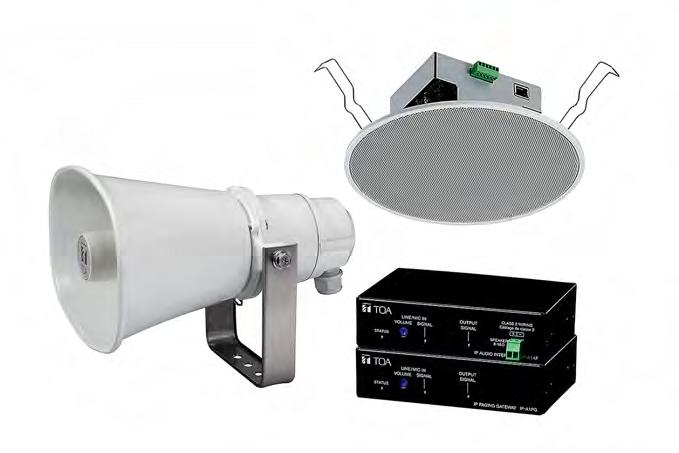
50 WORSHIP AVL July–August 2023 PRODUCTS
NX 915-SMA
IP-A1
WITH THE arrival of the DDK4000, DPA Microphones has released its first drum microphone kit. Consisting of the Danish brand’s 4055 kick drum, new 2012 Compact Cardioid and a 2015 Compact Wide Cardioid stereo pair, the kit also incorporates three 4099 CORE instrument mics. Specifically created for kick drum applications, the 4055 provides a tight, natural, well-defined sound and offers different sounds depending on its placement relative to the kick drum. Owing to its condenser mic capabilities, the 4055 produces a clean reproduction to a maximum SPL of 164dB. The asymmetric design provides easy positioning both inside and outside the kick drum, while the large housing and wind damping foam in front of the capsule, behind the grille, minimises air turbulence pickup in front of the kick drum hole.
The 2012 serves as an all-around, generalist pencil mic for capturing accurate, single-instrument pickup with clarity. According to the manufacturer, characteristics include exceptional transient


response and an intricate pickup, together with extended frequency and flat frequency responses for all live stage setups.
Designed for use as an overhead stereo pair on drum kits, the 2015 features uniform, wide cardioid directionality and a linear frequency response. The stereo pair can be positioned closer to the drum kit than normal and captures the balanced sound of the entire instrument with less bleed from
the stage. Both the 2012 and 2015 models are pre-polarised condenser mics, comprising a specifically designed 17mm capsule.

Added to minimise distortion and increase dynamic range, the inclusion of the 4099 CORE instrument mics rounds off the kit.
RØDE doubles up on innovation with 5th-gen mic
play recording.
outputs for easier integration into
for each of the 10 audio outputs, including the headphone and monitor outputs, the Bluetooth channel, onboard recording mix and the three USB outputs. This is described as particularly useful for streamers who need to create custom sub-mixes for different audio destinations, such as stream and chat applications and their headphone mix.

In addition to the advanced sub-mixing feature, firmware 1.1.1 introduces a number of system optimisations and workflow
users to capture these effects while maintaining the flexibility in postproduction that multitrack recording offers.
The RØDECaster Pro II’s companion software RØDE Central has also been updated to mirror all of the configuration options now available on the RØDECaster Pro II itself, including setting up the advanced APHEX audio processing, SMART pads and custom sub-mixes.
www.rode.com

July–August 2023 WORSHIP AVL 51 PRODUCTS
DPA launches first drum mic’ing kit
NT1 5th Generation
RØDECaster Pro II
DDK4000
2012 Compact Cardioid
Sennheiser evolves again
SENNHEISER HAS launched its 5th-generation of Evolution Wireless systems for filmmaking and video applications. Purpose-built for content creators, filmmakers and broadcasters, the EW-DP is a fully digital UHF wireless microphone system with a new portable design. At its heart is a compact, intelligent receiver that is said to help even novice users set up their audio with ease. The EW-DP EK receiver features a magnetic stacking system and can be controlled remotely via the Smart Assist app.
Besides the stackable EW-DP EK receiver, the series includes a bodypack transmitter for clip-on mics (EW-D SK), a handheld transmitter
Shure announces GLX-D+ Dual Band wireless system

WITH MORE than double the bandwidth compared to the first generation, the GLX-D+ Dual Band has been designed for guitarists, bassists, vocalists and presenters looking for improved wireless performance
Wireless Digital family, the EW-DP inherits the family features such as a low latency of 1.9ms and a wide 134dB dynamic input range, which reportedly ensures that everything from a soft whisper to a loud scream can be reliably captured without distortion.
The EW-DP ME 2 SET comes with a bodypack transmitter and the ME 2 omnidirectional clip-on (lavalier) microphone, while the EW-DP ME 4 SET includes a cardioid clip-on microphone for noisier environments. The EW-DP 835 SET contains a handheld transmitter with cardioid MMD 835 dynamic
microphone head. All sets come with a magnetic mounting plate kit, a BA 70 rechargeable battery, two standard AA batteries, a locking 3.5mm TRS to 3.5mm TRS cable, a locking 3.5mm TRS to XLR cable and a USB-C charging cable for the receiver.
According to the manufacturer, the EW-DP is the first portable wireless system that has magnetically stackable receivers with a user-facing OLED display and ergonomically designed controls. Thanks to the EW-DP’s automated frequency coordination, videographers can get up and running quickly – the receiver finds a free frequency (which can also be initiated via the Smart Assist app), then the transmitter is simply synced via Bluetooth.

The EW-DP “requires little RF or audio knowledge” – if any issues should occur, the system will guide users with Smart Notifications that give tips for troubleshooting and show them where to fix a problem. The system sends alerts for audio clipping, low battery, occupied frequencies, muted transmitters and unlinked devices –and all come with a suggestion of how to quickly solve the issue.
Automated setup, operation and monitoring can also happen remotely from the camera receiver via Bluetooth using the Smart Assist app on nearly any iOS or Android device. In the app, auto-frequency coordination creates reliable wireless connections for up to 16 systems on-set. Videographers can quickly and discreetly alter system settings across the room, and remotely override an accidentally activated mute button on the transmitter. The app also includes a support hub with video tutorials and detailed manuals
www.sennheiser.com
and selecting the cleanest available frequencies. The GLX-D+ avoids interference and dropouts, enabling users to focus on performing. It is available in rackmount, tabletop and guitar pedal receiver options with a wide selection of lavalier, headset and handheld microphone choices, including the SM58.
Featuring improved battery life over the previous generation, the GLX-D+ offers up to 12 hours of runtime. The system’s quick charge capability provides 1.5 hours of use from a 15-minute charge. It also features multiple smart rechargeability options. The lithium-ion SB904 battery can be charged directly on the tabletop and half-rack receivers or through a USB-C connector on the transmitter.
Engineered in a rugged metal design that can be completely integrated into a pedalboard (9V
DC power), the GLXD6+ digital wireless guitar pedal is said to make it easy for guitarists and bassists to go wireless without compromising tone or complicating their rigs. The guitar pedal receiver includes onstage transitions between instruments.
The system provides improved RF performance, antenna distribution and automatic frequency management for up to 11 half-rack systems in typical environments (16 under optimal conditions). Separately available Frequency Manager (GLXD+FM) and directional antenna accessories are required.
The tabletop and rackmountable GLX-D+ systems are available with three handheld wireless microphone options, including the SM58, Beta 58A and Beta 87A. Since all GLX-D+ dual-band wireless systems operate in a licence-free frequency range, users won’t have to worry about technical hurdles while travelling.
www.shure.com

52 WORSHIP AVL July–August 2023
GLX-D+ Dual Band
EW-DP SKP
The EW-DP series
DiGiCo increases power and speed with the Quantum852


DIGICO HAS announced the launch of the next generation of large-format live audio production mixing consoles. As with previous DiGiCo offerings, it has been designed from the ground up. Familiar, yet different, and with improved audio quality via enhanced algorithms, the Quantum852 is said to deliver a massive leap forward in processing power. It is neatly packaged with 1,000 nit LCD screens for full daylight operation and a newly designed worksurface, giving users the confidence that, true to the DiGiCo ethos, the Quantum852 has been designed not just for now, but for the future. With that firmly in mind, the Quantum852 also includes a raft

cooling. Further reducing the L-R/L-C-R/5.1 master busses. It each engine there are eight single or four redundant BNC MADI ports, sync inputs, dual USB 2.0 sockets,

ALTAIR WB-200 Series




PRODUCTS
The three 21.3-inch
Neutrik expands on three fronts
NEUTRIK’S SPEAKON series has been expanded further with the introduction of the NL4FXX and NL2FXX four-pole and twopole cable connectors. Featuring a locking boot that protects against unintended opening and a strain relief chuck snapping to the insert, the latest additions are housed in a two-compound casing. Conforming to relevant device standards, the powerCON NAC3FXXA and NAC3FXXB connectors are colour coded blue for power in and grey for power out. The single mode opticalCON MTP16 and the multimode MTP48 offer 16 and 48 data channels respectively in a single cable. Designed to offer high data capacity, reliability, speedy setup, instant playback and cost optimisation


Adamson updates Fletcher Machine

ADAMSON SYSTEMS
Engineering has announced two Fletcher Machine software
and 12 outputs, has only two layers, no auxiliary sends and an extended latency, compared
Suitable for any DAW that employs VST plugins, the Adamson Fletcher Machine VST Control connects the user’s DAW to an AFM via the Remote software. The connected AFM could be any one of a Stage Unit, a Traveler Model or the new vAFM.
software offers in terms of features such as Object Trajectories and general mixing functions, the vAFM is limited to a maximum of 24 inputs
as a demonstration tool that whets the appetite for further exploration with larger speaker setups and more complicated configurations.
The AFM VST Control allows users to directly control certain object parameters such as positioning and layer selection from within their DAW. Multiple instances of the AFM VST Control can be activated within the DAW, giving the user additional objects to control, limited only by their number of objects and the AFM in use. www.adamsonsystems.com
Analog Way updates LivePremier
The NAC3FXXA and NAC3FXXB
operate in harsh conditions. Housed in a compact, lightweight chassis, other features include a standard D-shape cut-out for simple integration, a push/ pull locking mechanism, an automatic sealing shutter and an anti-kink boot. Promoting onsite maintenance and repair with a replacement chassis to board connections clipped in place with manual connection of common LC patch cords, the Fibrefox HMA fibreoptic system converts a standardised LC patch cable into an expanded beam solution. Terminated with LC patch connectors, the Fibrefox range includes briDge connectors and pre-assembled cables, a weather-proofed Adaptor Box with several connectivity variants and the foxBRID multimode hermaphroditic connector module and Fibrefox rotary joint.

www.neutrik.com
LivePremier
TO ADDRESS the need for a larger number of Full HD sources and their possible backups, Analog Way has designed a new input card equipped with eight full-size HDMI 1.4 connectors. Each port can receive audio/video signals up to 2560x1600@60Hz or up to 4K@30Hz and is compatible with HDCP and advanced EDID management. The 8-HDMI input card can be freely combined with
any other input cards, allowing up to 32 inputs on a 4U chassis and up to 48 inputs on a 5U chassis. With such a high density of concurrent inputs, the manufacturer states that all switching and routing needs will be covered without requiring external matrix routers.
Analog Way has also launched a hybrid input card for LivePremier, equipped with one 2.5G Ethernet port and four 12G-SDI inputs. The
card, which can be freely combined with any other input cards, has four input streams that can be individually configured as either NDI Full Bandwidth or 12G-SDI as needed. Operators can easily use the Web RCS control interface to search through a list of available NDI sources on the network and select the ones they want to route and decode to the IP-SDI input card.
To meet the needs for large events and fixed installations, the manufacturer has added a LINK feature for the LivePremier platform. The LINK feature allows users to interconnect up to four units, no matter their type and size. The resulting system reportedly acts as a unique larger device controlled by one single Web RCS. Whatever the size of the displays and the origin of the outputs, they can all be entirely displayed on the multiviewer. The LINK function allows up to 16 inputs to be shared between linked units. If needed, a second LINK card can optionally be added to each Aquilon. The LINK card accepts various types of cabling covering all distances up to 2km.
www.analogway.com
54 WORSHIP AVL July–August 2023 PRODUCTS
Free firmware gives JVC full flexibility
JVC IS providing greater flexibility to existing customers with the launch of a free firmware update. The update enables users to select an NDI|HX3 option on its KY-PZ510N PTZ cameras to provide high-quality video with reduced latency, using a fraction of the bandwidth of full NDI. According to Vizrt, media organisations’ adoption of NDIenabled devices is growing at record pace, and the inclusion of a variety of NDI codecs means existing customers have more workflow options available, without the need to replace their hardware.

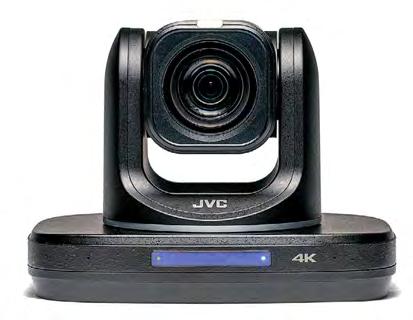
JVC says that an 80° horizontal angle of view and focal length of 21.8–261.8mm make its KY-PZ510N PTZ cameras ideal for a wide range of applications. The cameras also include SMART auto-tracking that follows one person and can be used to select one of multiple people within its field of view, while incorporated Vertical Interval Time Code (VITC) with Network Time
Big performance with the modular Carbonite Ultra 60
ROSS VIDEO is promising “big switcher performance in a mid-sized package” following the launch of its Carbonite Ultra 60. The company launched the first edition of Carbonite at NAB in 2011 and, according to Ross, the Carbonite Ultra is the most
The first Carbonite with an internal power supply, its modular 3U frame can be configured as 36x15 and can be expanded as requirements change. It shares the same feature set as the Carbonite Ultra and supports most major formats and
Protocol (NTP) provides the cameras with multi-camera synchronisation for live event production.
Part of the KY-PZ510 Series of cameras, the KY-PZ510N PTZs feature 4K60P HEVC Secure Reliable Transport (SRT) streaming, which is resilient to bandwidth fluctuations, data loss and intermittent connectivity, to ensure secure and error-free video delivery over the internet. The cameras also have UVC (USB Video Class) implementation through the USB-C interface, for ubiquitous webcam applications and integration. The KY-PZ510N can also simultaneously output NDI, SRT and RTMPS for hybrid local/remote workflows to deliver high-quality distribution to the world’s most popular CDNs.
The firmware update will be available from the KY-PZ510NBU and KY-PZ510NWU web pages as a free download for current owners.
www.pro.jvc.com
Ultra 60 is bigger, faster and more powerful, and is designed to enable customers looking to undertake more demanding productions to do so without having to spend money on a large switcher. Based on a software-defined hardware platform, the Carbonite Ultra 60’s modular design supports an I/O of up to 60x25 in HD or UHD.
processing capabilities are available with an additional licence key. The Carbonite Ultra 60 package features modular I/O boards to leverage the switcher’s feature set without buying more I/O than necessary. This modularity also supports future development.
www.rossvideo.com
Move SE brings lower-cost streaming options
PTZOPTICS HAS expanded its Move 4K series of PTZ streaming cameras with the Move SE line – a collection of low-cost, high-quality Management Platform

(CMP) which will add auto-tracking capabilities to the previous Gen2 camera models. The CMP software is available for download on Mac,
Link 4K camera also features SDI, HDMI, USB and IP output for complete versatility. The Link 4K features 4K at 60fps over HDMI, USB and IP, and provides 1080p 60fps resolution over Dante AV-H and SDI. The cameras can be mounted on wall, ceiling or pole mounts as well as in outdoor enclosures. The Link 4K’s automatic video inversion feature senses the camera’s orientation to save time on installation and setup.
while users can manage cameras can also be controlled using video production software such as OBS, Livestream Studio, Wirecast, vMix, mimoLive or Tricaster, and PTZOptics supply

endpoints, while every
The Link 4K’s built-in autotracking can track a specific person up to 90m away, even when other people are in frame,
joystick controllers like the IP joystick, serial joystick and SuperJoy. In addition, the cameras can be controlled remotely using tools such as NDI and Zoom.
www.ptzoptics.com
July–August 2023 WORSHIP AVL 55 PRODUCTS
SE
KY-PZ510N
Move
Link 4K
AJA launches Dante AV transmitter/receiver

VIDEO AND broadcast specialist
AJA has made a six pack of announcements, with the unveiling of a Dante AV 4K-T and 4K-R converter and firmware upgrades to five separate product lines. The Dante AV 4K-T and 4K-R transmitter/receiver converter was developed through a partnership with Audinate. It leverages the tools of Audinate’s Dante IP audio technology to enable transport and control of low-latency 4K/UltraHD/2K/HD/VESA
IP video and audio to/from 12G-SDI or HDMI 2.0 devices over a 1GigE Dante network. The converters provide a way to integrate video distribution in a networked facility and incorporate Dante AV Ultra IP video into a variety of environments.
Meanwhile, the company has also unveiled firmware releases for HELO Plus, ColorBox, BRIDGE LIVE,
leverage a previously recorded programme for a future streaming event.
The update supports the latest v1.6 BBC HLG LUTs, while an ORIONCONVERT update is now accessible with a gamma compensation function to ensure compatibility between different colour conversion philosophies.
FS-HDR and AJA Diskover Media
Edition. v2.0 firmware for HELO Plus introduces two licensable features, including simultaneous multichannel stereo audio streaming/recording and PlayToStream, which lets users
Format-agnostic routing with zero latency
BLACKMAGIC DESIGN has added three models to its Videohub 12G zero-latency video routers. The 10x10, 20x20 and 40x40 variants allow users to route any combination of SD, HD and Ultra HD signals on the same router at the same time. All models feature a front panel with shortcut buttons, an LCD which can display labels or live video and a machined metal spin knob for browsing video sources.
Videohub 12G allows users to plug all their SDI equipment into the router and do connections electronically, removing messy cabling. Any video input can be
connected to any video output, or even a single video input to multiple video outputs. Furthermore, users can route video to multiple streaming processors for all their broadcast platforms. Videohub 12G is also said to be ideal for adding extra inputs to a Blackmagic Design ATEM switcher.

All Videohub 12G models feature 12G-SDI connections which are multi-rate so they support any SD, HD and Ultra HD video format up to 2160p60, and will connect to any SD, HD-SDI, 3G-SDI, 6G-SDI and 12G-SDI equipment. Videohub 12G support for routing any video
ColorBox v2.0 brings a host of customer-requested features to AJA’s colour-managed workflow converter, including an add-on
AJA BRIDGE LIVE is AJA’s multichannel UltraHD and HD live video solution for remote production, contribution, collaboration, streaming and delivery. The v1.14 update introduces optional perpetual JPEG XS I/O licences alongside RTMP input, support for ST 2022-7 hitless redundancy and input autoreconfiguration.
could route up to 40 different video standards at the same time.
12G-SDI gives customers high frame rate Ultra HD via a single BNC connection that also plugs into regular HD equipment. The router also includes built-in SDI re-clocking on every 12G-SDI input, which regenerates the video signal for maximum quality.
All of the manufacturer’s Videohub routers can be remotely controlled,
It’s business time for Roland’s VR-6HD
six HDMI inputs for different views, and incorporate robotic PTZ cameras to change angles at the touch of a button; the VR-6HD features native support for select Canon, JVC, Panasonic, Sony, PTZOptics, Avonic and VISCA-compatible PTZ LAN cameras. Different brands can be mixed and matched, and up to six PTZ cameras can be operated simultaneously.
Videohub Master Control Pro is similar to the front panel and has a spin knob, LCD and shortcut buttons, while the Videohub Smart Control Pro model features all buttons and is generally programmed so the panel controls a single router output with each button programmed to a router input.
www.blackmagicdesign.com
DESIGNED AS a compact all-inone hub for livestreaming, Roland’s VR-6HD direct streaming AV mixer is a 28-channel audio mixing console with HDMI connectivity. With core features from Roland’s flagship
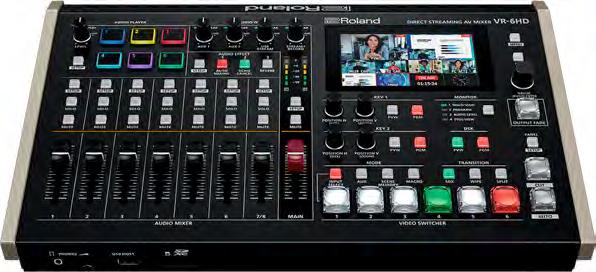
VR-120HD in a more compact format, the VR-6HD combines switching, audio mixing and LAN/ USB streaming encoders into a single unit. Users can connect multiple cameras and computers via
Sources can be assigned and switched on the fly, including camera inputs, presentation decks, still images and video clips. Custom feeds for live and online viewers can also be created by assigning composition layers to multiple busses.
The VR-6HD features a video matrix with three HDMI outputs, a USB-C streaming output and an Ethernet streaming output. Routing tools provide the flexibility to feed program displays, monitors, multi-view producer displays and online audiences simultaneously. Roland says the VR-6HD makes livestreaming easy with direct streaming over Ethernet, computer streaming over USB and adaptive bitrate support. The VR-6HD also provides simultaneous SDXC recording for archiving and distribution.
proav.roland.com
56 WORSHIP AVL July–August 2023 PRODUCTS
Dante AV 4K-T
Videohub 12G 10x10
Cameo is turning heads
EXPANDING ITS OTOS Series of lightweight, IP65-capable moving heads, Cameo has added two specialist models with the OTOS SP6 Spot Profile and the OTOS B5 Beam. The OTOS SP6 is an IP65 spot profile moving head with a 600W LED light source and an illuminance of 75,800 lx at a beam angle of 7°. With a 130mm front lens, the optical system offers a zoom range from 7–50°.

Weighing 34kg, Cameo says its IP65-rated housing means the OTOS SP6 is suitable for outdoor use in the live, event, theatre and TV sectors.
The OTOS SP6 also has two gobo wheels, a fivefacet prism and an integrated four-fold iris slider system with individual angulation and ±45° rotation. It also features two frost filters and a variable iris diaphragm. It works with CMY colour mixing and includes an additional colour wheel with six dichroic filters + open for saturated, powerful colours, while the linear CTO correction allows for variable adjustment of the colour temperature
in the range from 2,600K to 7,000K. Its adjustable PWM frequency (650Hz–25kHz) also means the OTOS SP6 is suitable for flicker-free use with film and TV cameras.
Weighing in at 33kg, the OTOS B5 is a beam moving head based on a 480W discharge lamp with a service life of 3,000 hours. It delivers an illuminance
15m and its 205mm front lens enables it to produce precise 1° beams that prevail even in dense lighting designs. Like the OTS SP6, its IP65-rated housing allows it to be used in all adverse weather conditions.
The effects section of the OTOS B5 includes a static gobo wheel with 19 gobos + open, as well as three rotating
levels to create a variety of mid-air effects. Users can draw from the full range of shades thanks to its integrated CMY colour mixing and the additional colour wheel with 14 dichroic filters for particularly saturated colours.
www.cameolight.com
GLP’s X5 runs to x5 products
GERMAN LIGHT Products (GLP) has expanded its X5 range to five products, with the launch of three X5 extensions. The X5 Bar 1000, X5 IP Bar 1000 and the X5 IP Maxx all share the X5’s features and can be combined with each other to achieve greater consistency in terms of colours and white light.
GLP’s X5 IP Bar 1000 is IP65certified and its linear LED tilt bar is equipped with 18 40W RGBL LEDs. It offers a large zoom range and the iQ.Gamut colour calibration algorithm, while its square lens design enables light curtains in the narrowest zoom


Claypaky spotlights four premieres
ITALIAN LIGHTING specialist
Claypaky has announced four arrivals to its growing catalogue. With dense, solid beams of light, the Skylos fits a custom 300W white light laser source to provide an extremely parallel, uniform beam from a 300mm front lens. Designed to be more versatile than a classic searchlight, its beam has no visible hotspots and the beam angle can be adjusted from 0.5–5°. With a lightweight and compact IP66-rated body, the unit can be rigged on trussing for use on
tours and is capable of working in extreme weather conditions and in environments with high marine salinity and a high risk of corrosion. Its internal heating system means it can work at temperatures as low top-of-the-range, weather-resistant
white 900W (7,000K) and is capable of output. Its zoom can be adjusted over a linear 5.5–50° range (9:1) and Claypaky claims that its exclusive
light loss or colour shift when gobos are inserted into the beam.
The Sharpy-X-Spot is a simplified Sharpy-X-Frame model which fits a 550W arc lamp to produce deep, vivid, uniform colours. An optional beam shaper module turns the Sharpy-X-Spot into a fully fledged Sharpy-X-Frame, and the module
range of only 5° and an even and homogeneous colour distribution in the wash up to 70°. The identically equipped sister model, the X5 Bar 1000, is for indoor use only. The X5 IP Maxx has 37 LEDs in an X5 specification.
Meanwhile, the X5 iQ.Gamut colour algorithm has also been added to GLP’s IP65-certified FUSION X-PAR 18 Z, which is based on the X-PAR 12 Z launched last year. The model benefits from a more powerful 180W LED engine in an almost identical form factor.
www.glp.de
product firmware.
Finally, the Buddylight is a followspot system which follows performers and speakers automatically. The Buddylight can be used either in an Art-Net or DMX network or in standalone mode.

www.claypaky.it

July–August 2023 WORSHIP AVL 57
X5 Bar 1000
OTOS B5
Buddylight
Skylos
Design-build vs design-bid
Vero Tabares, marketing director at Washington Professional Systems (WPS), looks at the benefits each method can bring to houses of worship
WPS’S HISTORY IN THE PRO AV integration industry dates back to the 1950s when Chuck and Marge Levin founded the Washington Music Center in 1958 in Washington, DC. In 1968, they opened a storefront location in Wheaton, Maryland, which still exists today. In 1976, the Music Center began offering small-scale system installations to local businesses and houses of worship. Later, in 1985, brothers Robert and Alan decided to focus purely on the commercial side of the business, and WPS was established. “From the very beginning, houses of worship have been a pretty big focus for us,” explains Vero Tabares, marketing director at WPS. “We do both small and large churches – I think one of the largest houses of worship that we’ve done was Victory Christian Ministries, which has a branch in the UK. That was a newbuild construction and we went in and provided the infrastructure support,
such as cabling, Ethernet, audio and set up all of the audio networks. However, most of the time, we’re working with the AV consultant to deliver the project but, occasionally, we’ll get design-build projects that start from scratch.”
In the US, it’s common for a church to seek help from an AV consultant, to avoid any potential conflict of interest that could arise if an integrator were to design and install a new AV system. Once the AV consultant has designed the system, the client, with assistance from the consultant, will contact an integrator to bid or submit a proposal.
“The benefit of the design-build process is that it’s cheaper – you don’t have to pay for a consultant and the process will be faster as well,” adds Tabares. “It’s definitely an added cost but it’s usually for larger projects, in particular new-builds. If you’ve got a project that’s going to
cost more than US$500,000, for example, churches will most likely go through a consultant. The services of a consultant are often brought in if the church doesn’t understand the process and doesn’t know what it needs for the space. There’s a lot of value behind a consultant – they’ll carry out acoustic testing and tune the system afterwards. For smaller projects, I think it would be costprohibitive.”
While there are specialist integrators that only focus on houses of worship, reducing the need for an AV consultant, Tabares describes WPS as a jack of all trades. “We have the expertise to do houses of worship, universities, stadiums, government buildings, you name it. It also means that you don’t put all your eggs in one basket if there’s a downturn.”

WPS has recently completed a series of audio upgrades at Calvary Church in Clearwater, Florida, based

church three speaker alternatives that included different manufacturers and, ultimately, the church opted for d&b. The Soundscape solution quickly became the system of choice by addressing both the musical demands of the Calvary worship style while simultaneously fitting within the limited space available for a system without causing sightline obstructions to the large video displays, all while meeting the project’s budget. “The church is also constructing a second location about two hours north of Clearwater in Sunrise Beach,” describes Tabares. “I would imagine we’ll be doing the design-build for them and include lighting as well as audio and video.”
One of the problems at Calvary Church was that before the upgrade, audio delays and reverberations meant that worshippers were receiving inconsistent audio signals from the stage. “I think immersive technologies are going to be constantly improving,” explains Tabares, “and it helps people feel like they’re part of the audience. Once you’ve experienced it, there’s going to be more of an incentive to attend each Sunday and benefit from the full effect of systems such as d&b’s Soundscape.”
Looking ahead, Tabares hopes that WPS can become more involved in design-build projects, which would push the company’s focus further towards houses of worship. “But at the moment, with the economy the way that it is, it’s very difficult for churches to set money aside to renovate their space,” he reports. “But when we are able to convince them that these improvements will inevitably help their congregation, the reaction is overwhelmingly positive.”
www.wpsproav.com
58 WORSHIP AVL July–August 2023 THE TECH VIEW
WPS recently installed a d&b Soundscape system at Calvary Church
Marketing director, Vero Tabares
The Fletcher Machine Remote software offers an easy-to-use yet complete set of mixing functionalities, including EQ, compression, auxiliary sends, and much more.



To learn more about the Fletcher Machine visit our website at www.adamsonsystems.com
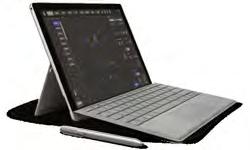




VIRTUAL FLETCHER MACHINE Connects with the Fletcher Machine Remote software without the requirement of a dedicated hardware engine. Download now | Free of charge! | JUNE 14 - 16 | Booth Number 5569 Come visit us MIXER PAGE Send on Fader for Speakers, Aux, Reverb and VCAs Dedicated Page for Solo in Place Custom Fader Page Mixdown






























































































































































 Photo: Tanner VonnahmeI, unsplash
Photo: Tanner VonnahmeI, unsplash





















































 Active Audio an Arbane Groupe brand
Active Audio an Arbane Groupe brand



































































































